Project Management Project Management in Pakistan
VerifiedAdded on 2022/10/19
|34
|6010
|245
AI Summary
7 The selection criteria by which you will evaluate design alternatives 8 Exit strategy 9 Project Management (How and When) 9 Deliverables 13 Detailed design drawing 13 Scaled model 14 Physical Prototype 15 Description of procedures 17 Computer program code, flow chart documentation 17 Data from experiments, trials and monitoring 19 Personnel training instructions 20 Technology transfer 21 Project budget for the development 22 Communication and co-ordination 23 Special topics 24 Team qualifications for the project 25 References 26 Appendix 32 Executive summary The paper explores the project management of
Contribute Materials
Your contribution can guide someone’s learning journey. Share your
documents today.
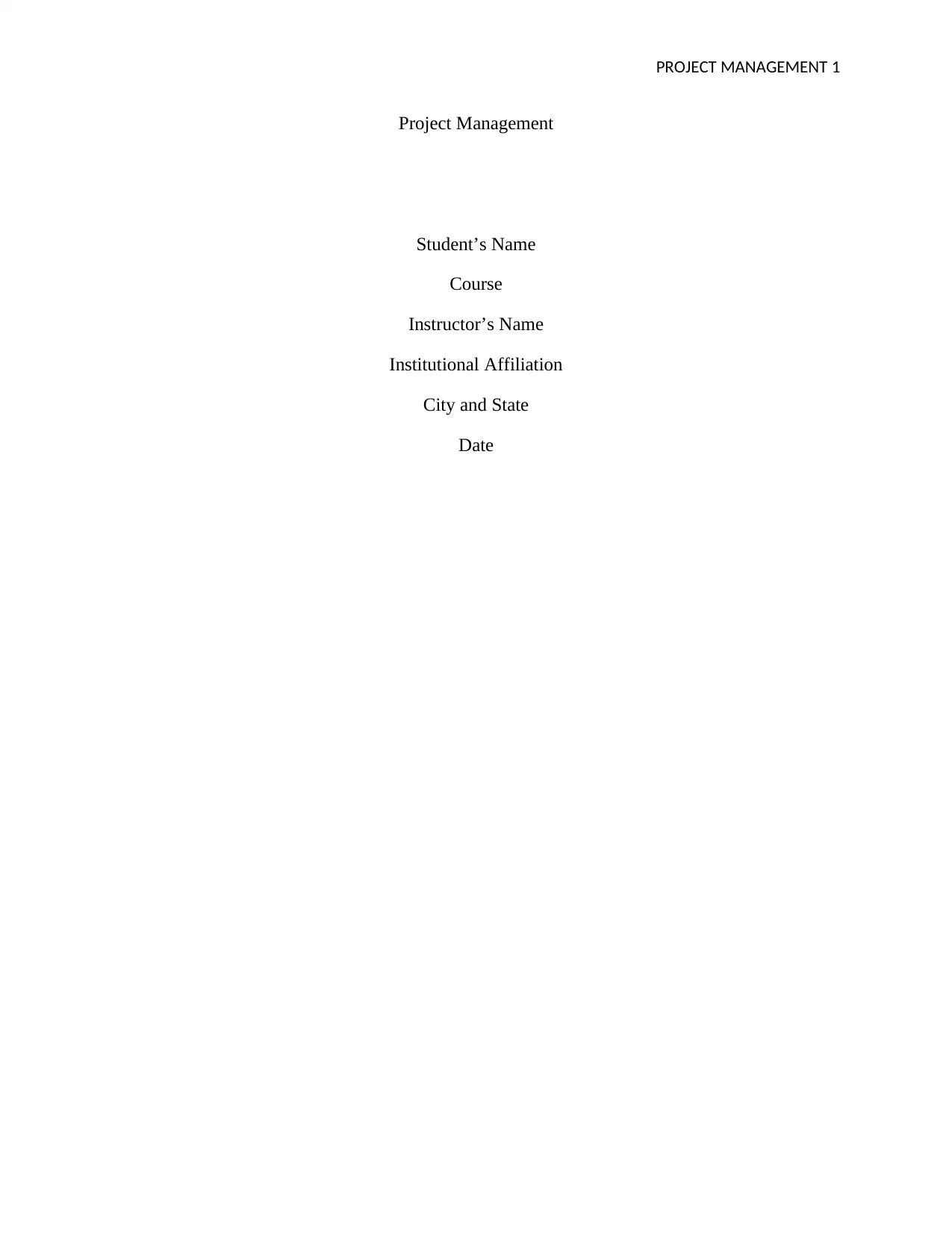
PROJECT MANAGEMENT 1
Project Management
Student’s Name
Course
Instructor’s Name
Institutional Affiliation
City and State
Date
Project Management
Student’s Name
Course
Instructor’s Name
Institutional Affiliation
City and State
Date
Secure Best Marks with AI Grader
Need help grading? Try our AI Grader for instant feedback on your assignments.
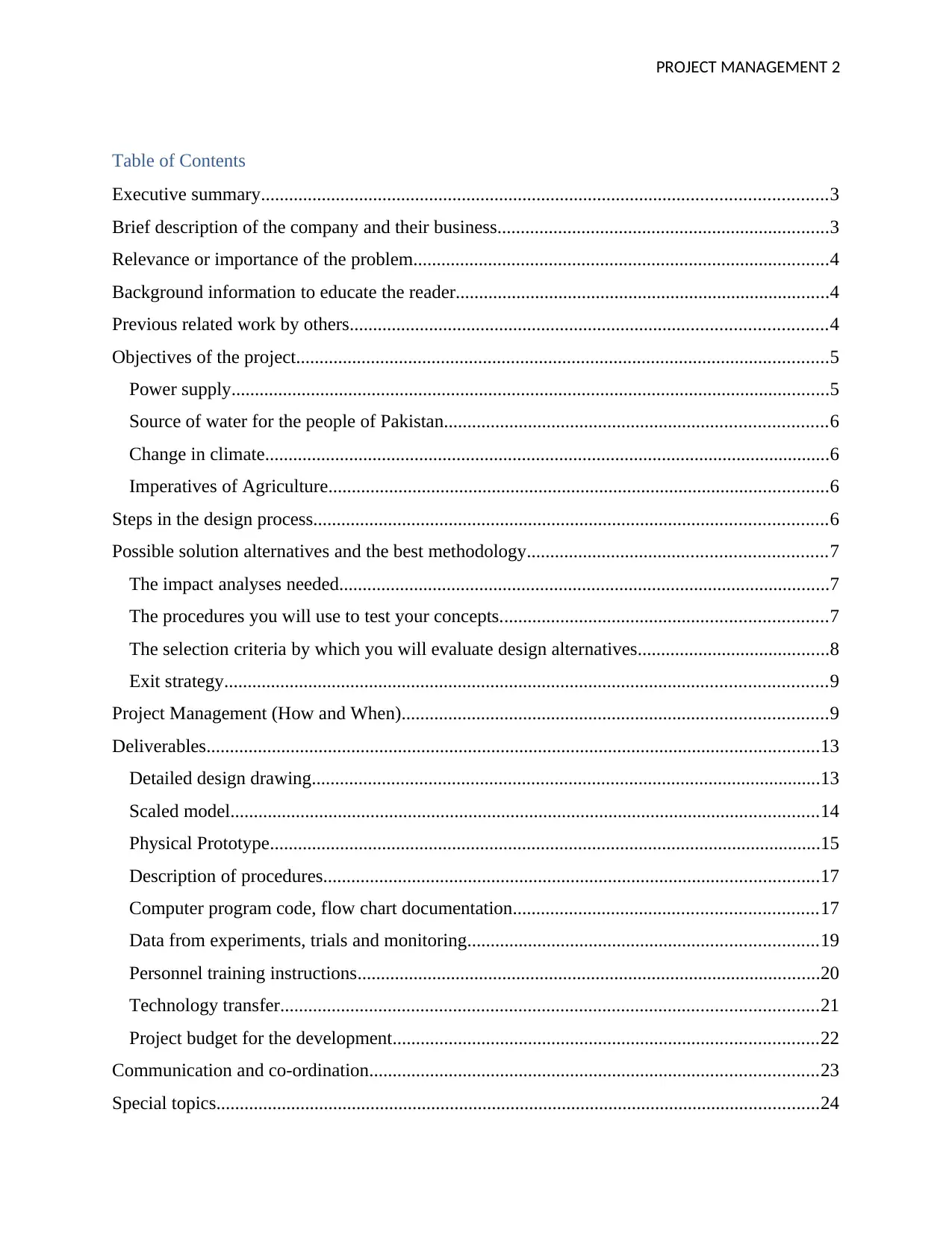
PROJECT MANAGEMENT 2
Table of Contents
Executive summary.........................................................................................................................3
Brief description of the company and their business.......................................................................3
Relevance or importance of the problem.........................................................................................4
Background information to educate the reader................................................................................4
Previous related work by others......................................................................................................4
Objectives of the project..................................................................................................................5
Power supply................................................................................................................................5
Source of water for the people of Pakistan..................................................................................6
Change in climate.........................................................................................................................6
Imperatives of Agriculture...........................................................................................................6
Steps in the design process..............................................................................................................6
Possible solution alternatives and the best methodology................................................................7
The impact analyses needed.........................................................................................................7
The procedures you will use to test your concepts......................................................................7
The selection criteria by which you will evaluate design alternatives.........................................8
Exit strategy.................................................................................................................................9
Project Management (How and When)...........................................................................................9
Deliverables...................................................................................................................................13
Detailed design drawing.............................................................................................................13
Scaled model..............................................................................................................................14
Physical Prototype......................................................................................................................15
Description of procedures..........................................................................................................17
Computer program code, flow chart documentation.................................................................17
Data from experiments, trials and monitoring...........................................................................19
Personnel training instructions...................................................................................................20
Technology transfer...................................................................................................................21
Project budget for the development...........................................................................................22
Communication and co-ordination................................................................................................23
Special topics.................................................................................................................................24
Table of Contents
Executive summary.........................................................................................................................3
Brief description of the company and their business.......................................................................3
Relevance or importance of the problem.........................................................................................4
Background information to educate the reader................................................................................4
Previous related work by others......................................................................................................4
Objectives of the project..................................................................................................................5
Power supply................................................................................................................................5
Source of water for the people of Pakistan..................................................................................6
Change in climate.........................................................................................................................6
Imperatives of Agriculture...........................................................................................................6
Steps in the design process..............................................................................................................6
Possible solution alternatives and the best methodology................................................................7
The impact analyses needed.........................................................................................................7
The procedures you will use to test your concepts......................................................................7
The selection criteria by which you will evaluate design alternatives.........................................8
Exit strategy.................................................................................................................................9
Project Management (How and When)...........................................................................................9
Deliverables...................................................................................................................................13
Detailed design drawing.............................................................................................................13
Scaled model..............................................................................................................................14
Physical Prototype......................................................................................................................15
Description of procedures..........................................................................................................17
Computer program code, flow chart documentation.................................................................17
Data from experiments, trials and monitoring...........................................................................19
Personnel training instructions...................................................................................................20
Technology transfer...................................................................................................................21
Project budget for the development...........................................................................................22
Communication and co-ordination................................................................................................23
Special topics.................................................................................................................................24
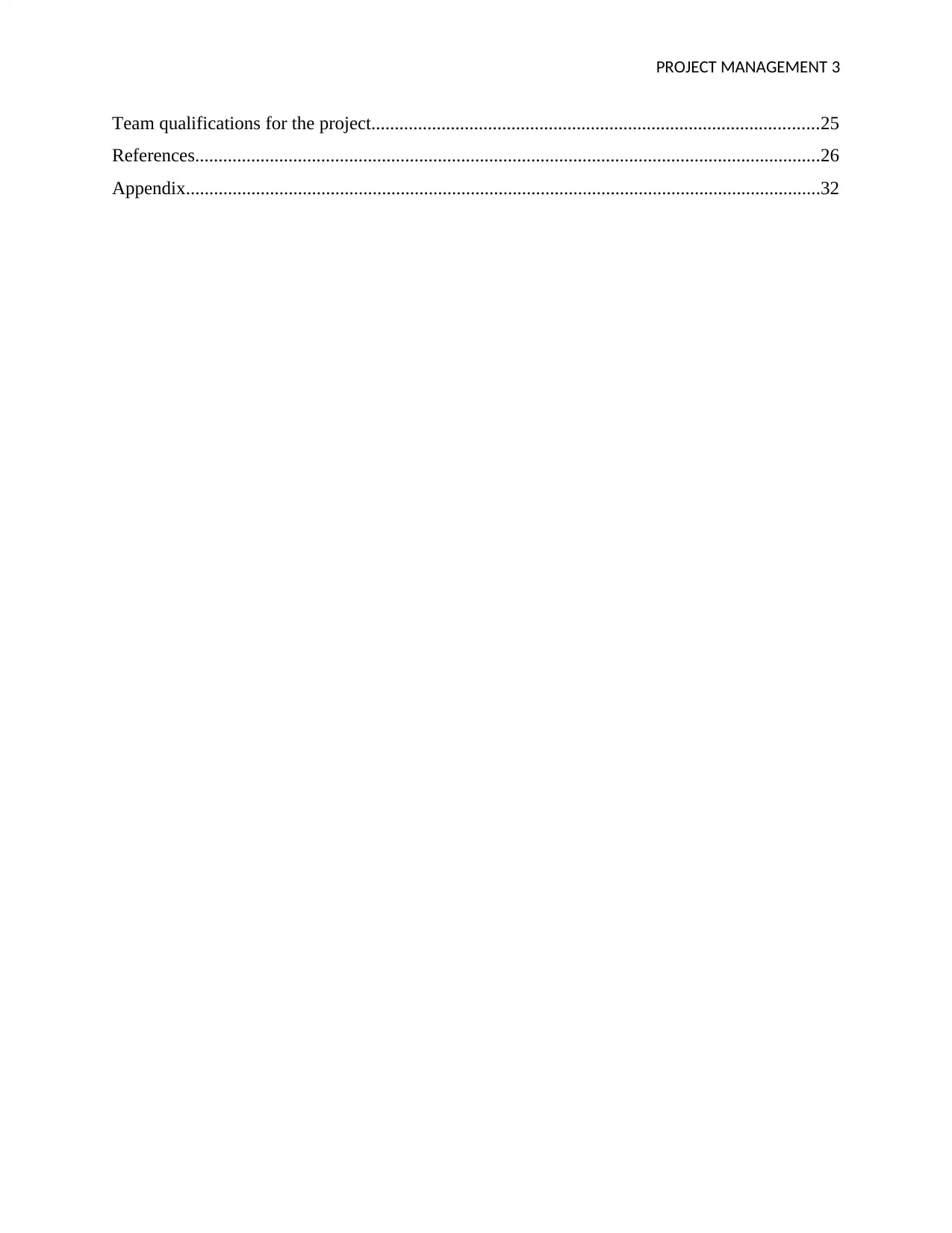
PROJECT MANAGEMENT 3
Team qualifications for the project................................................................................................25
References......................................................................................................................................26
Appendix........................................................................................................................................32
Team qualifications for the project................................................................................................25
References......................................................................................................................................26
Appendix........................................................................................................................................32
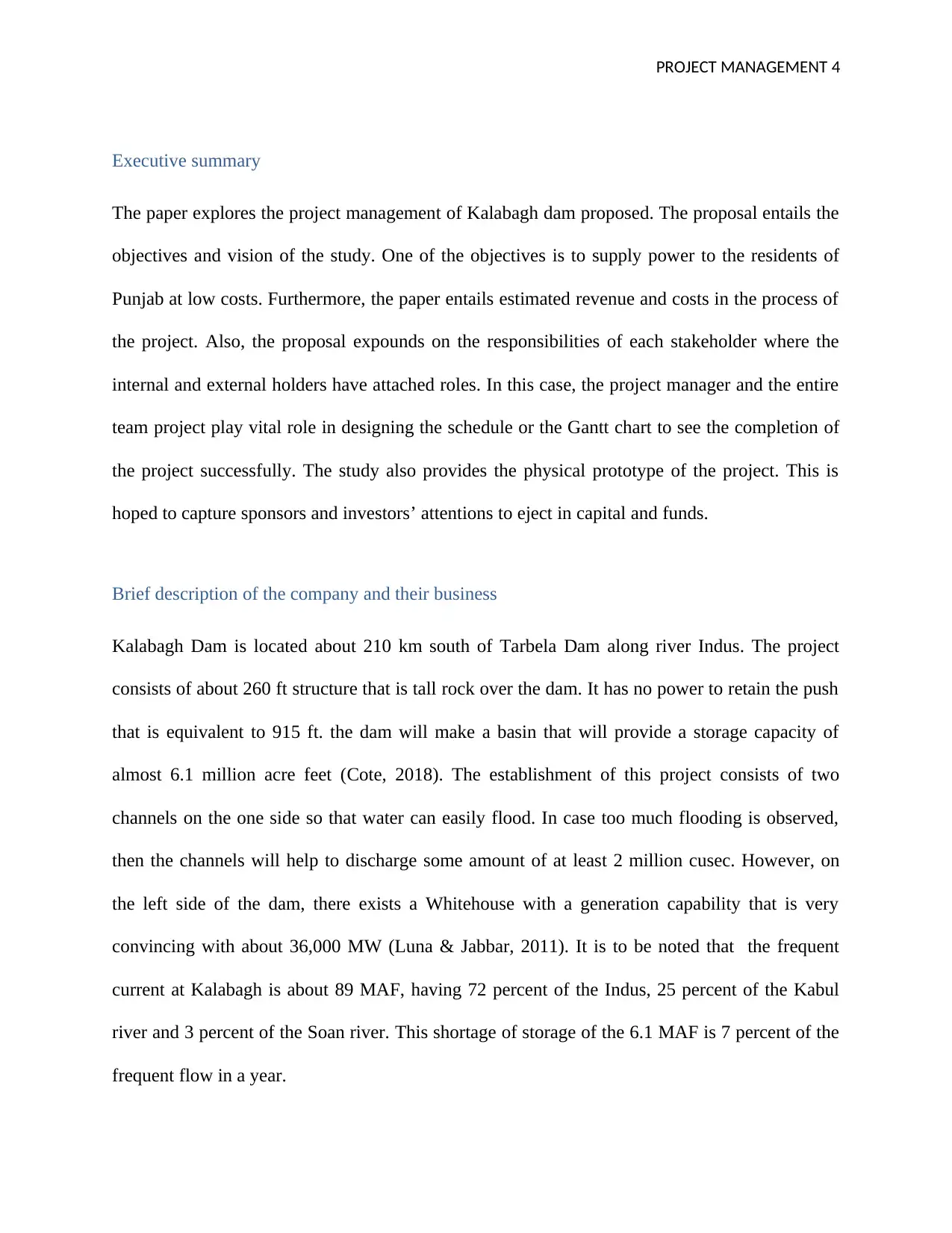
PROJECT MANAGEMENT 4
Executive summary
The paper explores the project management of Kalabagh dam proposed. The proposal entails the
objectives and vision of the study. One of the objectives is to supply power to the residents of
Punjab at low costs. Furthermore, the paper entails estimated revenue and costs in the process of
the project. Also, the proposal expounds on the responsibilities of each stakeholder where the
internal and external holders have attached roles. In this case, the project manager and the entire
team project play vital role in designing the schedule or the Gantt chart to see the completion of
the project successfully. The study also provides the physical prototype of the project. This is
hoped to capture sponsors and investors’ attentions to eject in capital and funds.
Brief description of the company and their business
Kalabagh Dam is located about 210 km south of Tarbela Dam along river Indus. The project
consists of about 260 ft structure that is tall rock over the dam. It has no power to retain the push
that is equivalent to 915 ft. the dam will make a basin that will provide a storage capacity of
almost 6.1 million acre feet (Cote, 2018). The establishment of this project consists of two
channels on the one side so that water can easily flood. In case too much flooding is observed,
then the channels will help to discharge some amount of at least 2 million cusec. However, on
the left side of the dam, there exists a Whitehouse with a generation capability that is very
convincing with about 36,000 MW (Luna & Jabbar, 2011). It is to be noted that the frequent
current at Kalabagh is about 89 MAF, having 72 percent of the Indus, 25 percent of the Kabul
river and 3 percent of the Soan river. This shortage of storage of the 6.1 MAF is 7 percent of the
frequent flow in a year.
Executive summary
The paper explores the project management of Kalabagh dam proposed. The proposal entails the
objectives and vision of the study. One of the objectives is to supply power to the residents of
Punjab at low costs. Furthermore, the paper entails estimated revenue and costs in the process of
the project. Also, the proposal expounds on the responsibilities of each stakeholder where the
internal and external holders have attached roles. In this case, the project manager and the entire
team project play vital role in designing the schedule or the Gantt chart to see the completion of
the project successfully. The study also provides the physical prototype of the project. This is
hoped to capture sponsors and investors’ attentions to eject in capital and funds.
Brief description of the company and their business
Kalabagh Dam is located about 210 km south of Tarbela Dam along river Indus. The project
consists of about 260 ft structure that is tall rock over the dam. It has no power to retain the push
that is equivalent to 915 ft. the dam will make a basin that will provide a storage capacity of
almost 6.1 million acre feet (Cote, 2018). The establishment of this project consists of two
channels on the one side so that water can easily flood. In case too much flooding is observed,
then the channels will help to discharge some amount of at least 2 million cusec. However, on
the left side of the dam, there exists a Whitehouse with a generation capability that is very
convincing with about 36,000 MW (Luna & Jabbar, 2011). It is to be noted that the frequent
current at Kalabagh is about 89 MAF, having 72 percent of the Indus, 25 percent of the Kabul
river and 3 percent of the Soan river. This shortage of storage of the 6.1 MAF is 7 percent of the
frequent flow in a year.
Secure Best Marks with AI Grader
Need help grading? Try our AI Grader for instant feedback on your assignments.
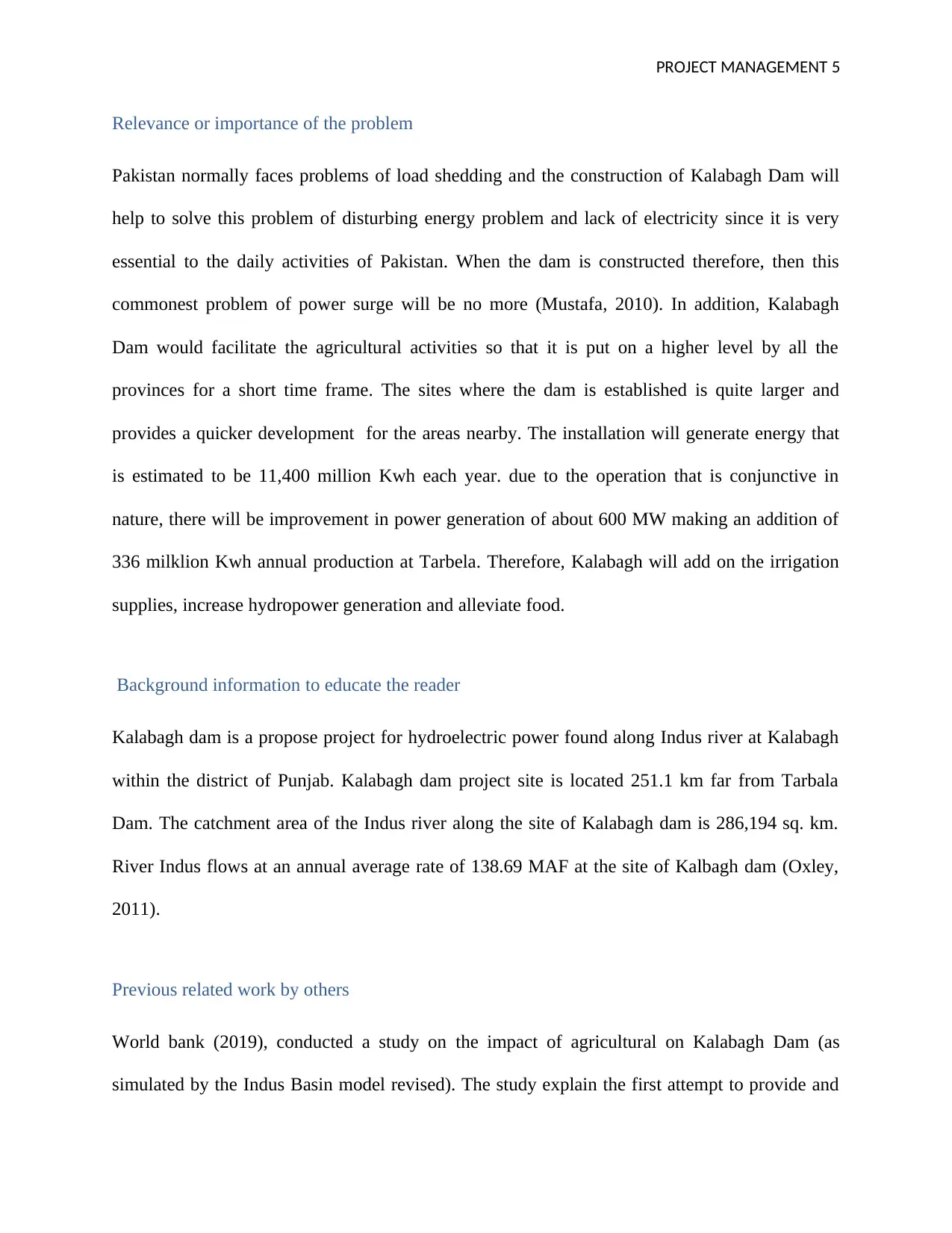
PROJECT MANAGEMENT 5
Relevance or importance of the problem
Pakistan normally faces problems of load shedding and the construction of Kalabagh Dam will
help to solve this problem of disturbing energy problem and lack of electricity since it is very
essential to the daily activities of Pakistan. When the dam is constructed therefore, then this
commonest problem of power surge will be no more (Mustafa, 2010). In addition, Kalabagh
Dam would facilitate the agricultural activities so that it is put on a higher level by all the
provinces for a short time frame. The sites where the dam is established is quite larger and
provides a quicker development for the areas nearby. The installation will generate energy that
is estimated to be 11,400 million Kwh each year. due to the operation that is conjunctive in
nature, there will be improvement in power generation of about 600 MW making an addition of
336 milklion Kwh annual production at Tarbela. Therefore, Kalabagh will add on the irrigation
supplies, increase hydropower generation and alleviate food.
Background information to educate the reader
Kalabagh dam is a propose project for hydroelectric power found along Indus river at Kalabagh
within the district of Punjab. Kalabagh dam project site is located 251.1 km far from Tarbala
Dam. The catchment area of the Indus river along the site of Kalabagh dam is 286,194 sq. km.
River Indus flows at an annual average rate of 138.69 MAF at the site of Kalbagh dam (Oxley,
2011).
Previous related work by others
World bank (2019), conducted a study on the impact of agricultural on Kalabagh Dam (as
simulated by the Indus Basin model revised). The study explain the first attempt to provide and
Relevance or importance of the problem
Pakistan normally faces problems of load shedding and the construction of Kalabagh Dam will
help to solve this problem of disturbing energy problem and lack of electricity since it is very
essential to the daily activities of Pakistan. When the dam is constructed therefore, then this
commonest problem of power surge will be no more (Mustafa, 2010). In addition, Kalabagh
Dam would facilitate the agricultural activities so that it is put on a higher level by all the
provinces for a short time frame. The sites where the dam is established is quite larger and
provides a quicker development for the areas nearby. The installation will generate energy that
is estimated to be 11,400 million Kwh each year. due to the operation that is conjunctive in
nature, there will be improvement in power generation of about 600 MW making an addition of
336 milklion Kwh annual production at Tarbela. Therefore, Kalabagh will add on the irrigation
supplies, increase hydropower generation and alleviate food.
Background information to educate the reader
Kalabagh dam is a propose project for hydroelectric power found along Indus river at Kalabagh
within the district of Punjab. Kalabagh dam project site is located 251.1 km far from Tarbala
Dam. The catchment area of the Indus river along the site of Kalabagh dam is 286,194 sq. km.
River Indus flows at an annual average rate of 138.69 MAF at the site of Kalbagh dam (Oxley,
2011).
Previous related work by others
World bank (2019), conducted a study on the impact of agricultural on Kalabagh Dam (as
simulated by the Indus Basin model revised). The study explain the first attempt to provide and
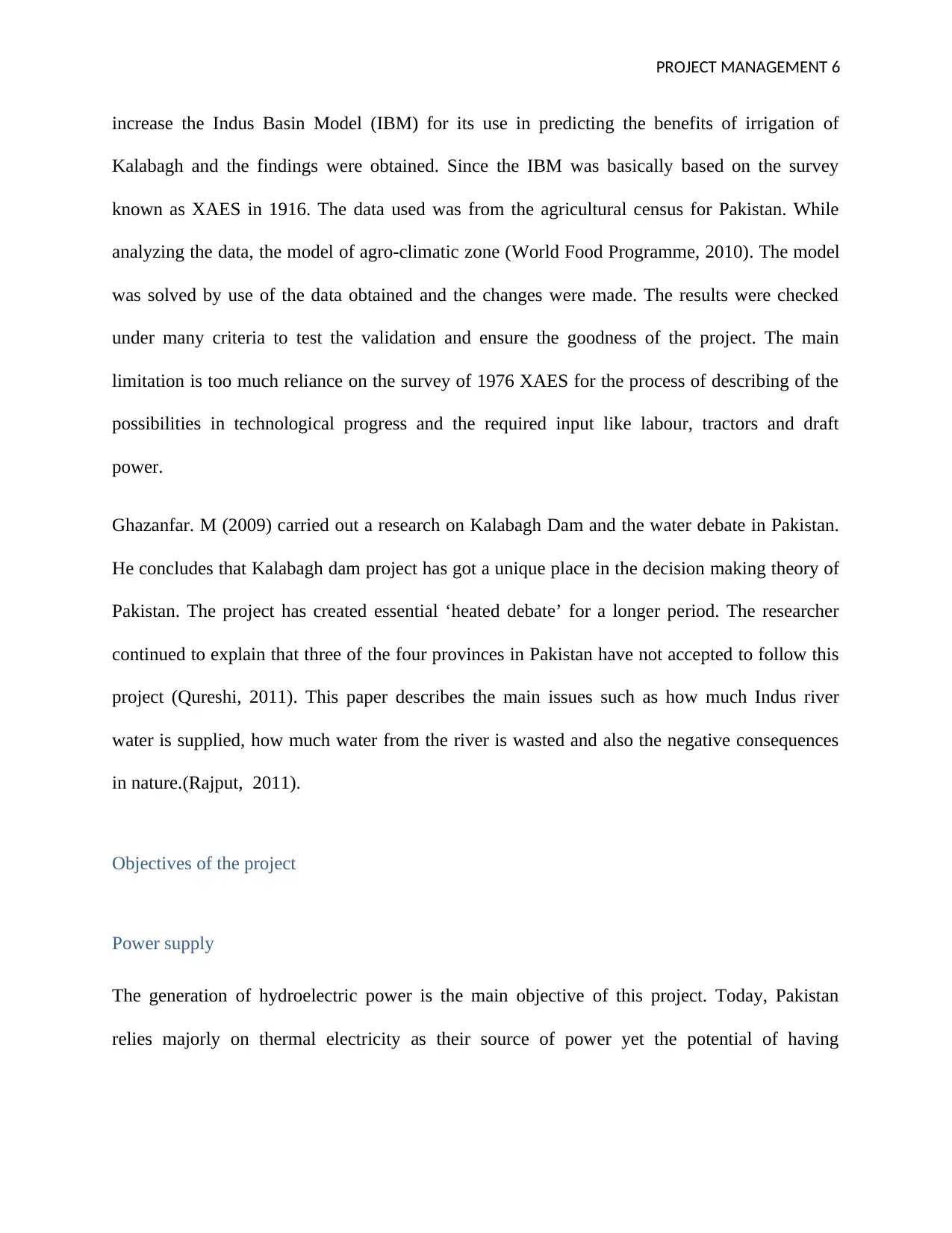
PROJECT MANAGEMENT 6
increase the Indus Basin Model (IBM) for its use in predicting the benefits of irrigation of
Kalabagh and the findings were obtained. Since the IBM was basically based on the survey
known as XAES in 1916. The data used was from the agricultural census for Pakistan. While
analyzing the data, the model of agro-climatic zone (World Food Programme, 2010). The model
was solved by use of the data obtained and the changes were made. The results were checked
under many criteria to test the validation and ensure the goodness of the project. The main
limitation is too much reliance on the survey of 1976 XAES for the process of describing of the
possibilities in technological progress and the required input like labour, tractors and draft
power.
Ghazanfar. M (2009) carried out a research on Kalabagh Dam and the water debate in Pakistan.
He concludes that Kalabagh dam project has got a unique place in the decision making theory of
Pakistan. The project has created essential ‘heated debate’ for a longer period. The researcher
continued to explain that three of the four provinces in Pakistan have not accepted to follow this
project (Qureshi, 2011). This paper describes the main issues such as how much Indus river
water is supplied, how much water from the river is wasted and also the negative consequences
in nature.(Rajput, 2011).
Objectives of the project
Power supply
The generation of hydroelectric power is the main objective of this project. Today, Pakistan
relies majorly on thermal electricity as their source of power yet the potential of having
increase the Indus Basin Model (IBM) for its use in predicting the benefits of irrigation of
Kalabagh and the findings were obtained. Since the IBM was basically based on the survey
known as XAES in 1916. The data used was from the agricultural census for Pakistan. While
analyzing the data, the model of agro-climatic zone (World Food Programme, 2010). The model
was solved by use of the data obtained and the changes were made. The results were checked
under many criteria to test the validation and ensure the goodness of the project. The main
limitation is too much reliance on the survey of 1976 XAES for the process of describing of the
possibilities in technological progress and the required input like labour, tractors and draft
power.
Ghazanfar. M (2009) carried out a research on Kalabagh Dam and the water debate in Pakistan.
He concludes that Kalabagh dam project has got a unique place in the decision making theory of
Pakistan. The project has created essential ‘heated debate’ for a longer period. The researcher
continued to explain that three of the four provinces in Pakistan have not accepted to follow this
project (Qureshi, 2011). This paper describes the main issues such as how much Indus river
water is supplied, how much water from the river is wasted and also the negative consequences
in nature.(Rajput, 2011).
Objectives of the project
Power supply
The generation of hydroelectric power is the main objective of this project. Today, Pakistan
relies majorly on thermal electricity as their source of power yet the potential of having
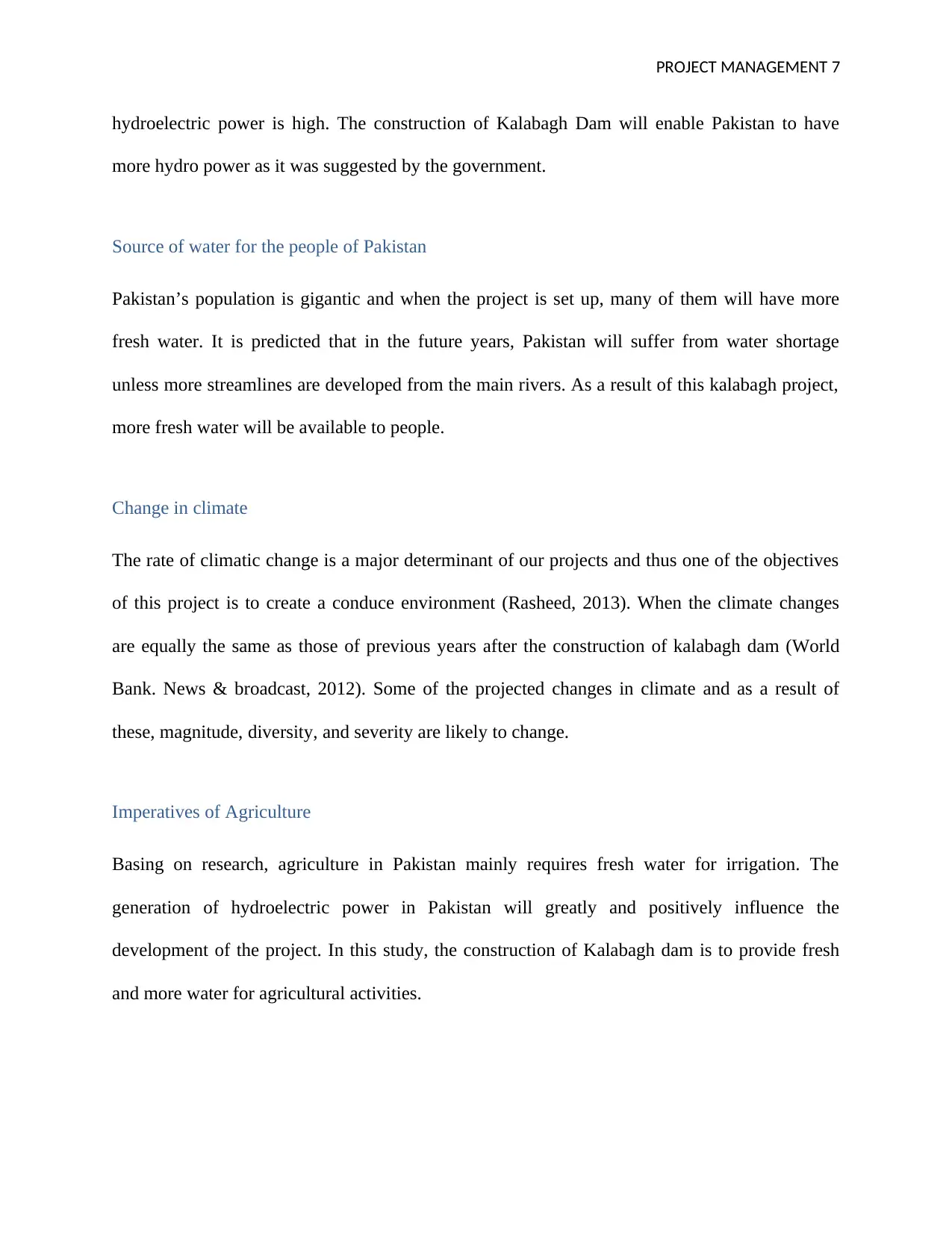
PROJECT MANAGEMENT 7
hydroelectric power is high. The construction of Kalabagh Dam will enable Pakistan to have
more hydro power as it was suggested by the government.
Source of water for the people of Pakistan
Pakistan’s population is gigantic and when the project is set up, many of them will have more
fresh water. It is predicted that in the future years, Pakistan will suffer from water shortage
unless more streamlines are developed from the main rivers. As a result of this kalabagh project,
more fresh water will be available to people.
Change in climate
The rate of climatic change is a major determinant of our projects and thus one of the objectives
of this project is to create a conduce environment (Rasheed, 2013). When the climate changes
are equally the same as those of previous years after the construction of kalabagh dam (World
Bank. News & broadcast, 2012). Some of the projected changes in climate and as a result of
these, magnitude, diversity, and severity are likely to change.
Imperatives of Agriculture
Basing on research, agriculture in Pakistan mainly requires fresh water for irrigation. The
generation of hydroelectric power in Pakistan will greatly and positively influence the
development of the project. In this study, the construction of Kalabagh dam is to provide fresh
and more water for agricultural activities.
hydroelectric power is high. The construction of Kalabagh Dam will enable Pakistan to have
more hydro power as it was suggested by the government.
Source of water for the people of Pakistan
Pakistan’s population is gigantic and when the project is set up, many of them will have more
fresh water. It is predicted that in the future years, Pakistan will suffer from water shortage
unless more streamlines are developed from the main rivers. As a result of this kalabagh project,
more fresh water will be available to people.
Change in climate
The rate of climatic change is a major determinant of our projects and thus one of the objectives
of this project is to create a conduce environment (Rasheed, 2013). When the climate changes
are equally the same as those of previous years after the construction of kalabagh dam (World
Bank. News & broadcast, 2012). Some of the projected changes in climate and as a result of
these, magnitude, diversity, and severity are likely to change.
Imperatives of Agriculture
Basing on research, agriculture in Pakistan mainly requires fresh water for irrigation. The
generation of hydroelectric power in Pakistan will greatly and positively influence the
development of the project. In this study, the construction of Kalabagh dam is to provide fresh
and more water for agricultural activities.
Paraphrase This Document
Need a fresh take? Get an instant paraphrase of this document with our AI Paraphraser
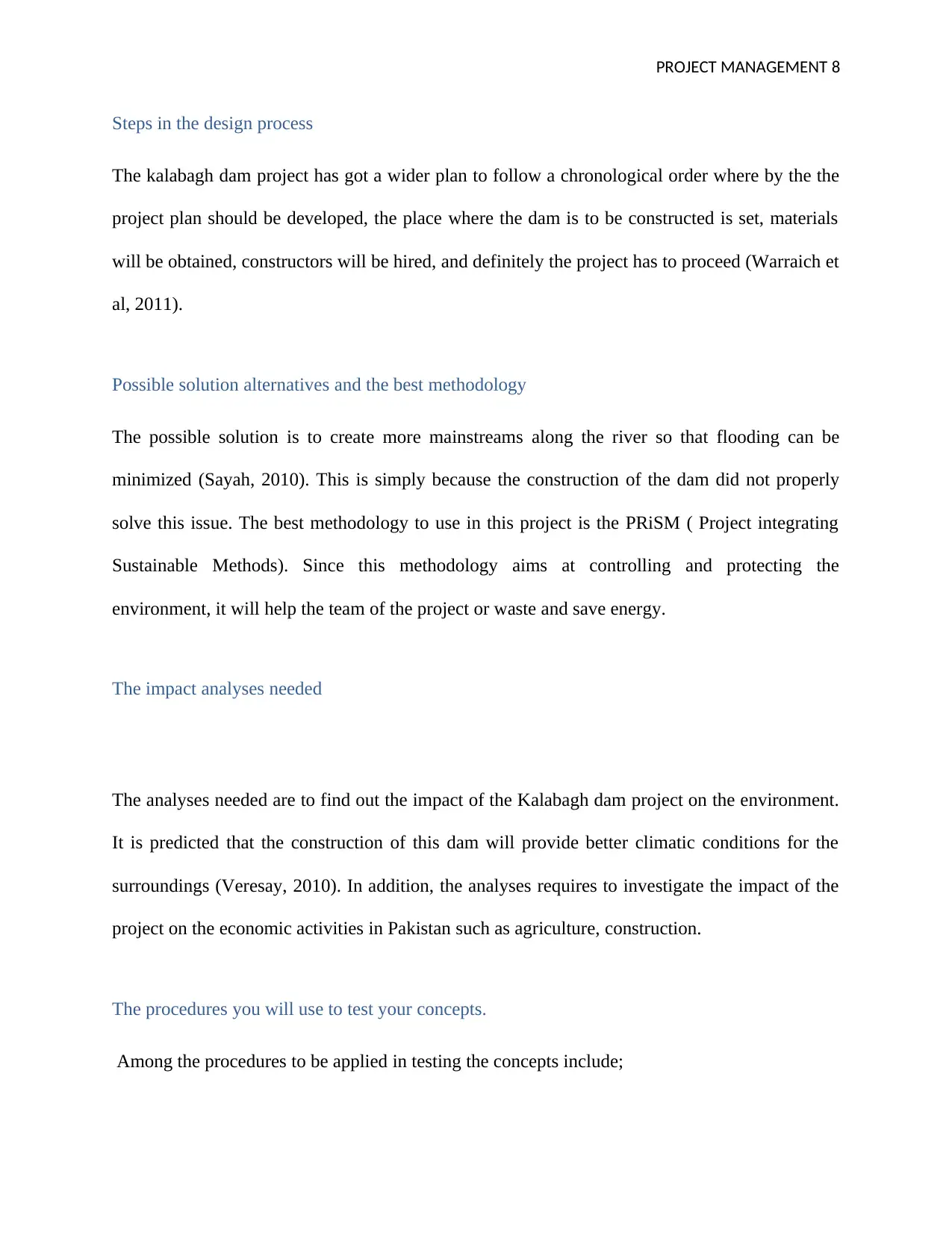
PROJECT MANAGEMENT 8
Steps in the design process
The kalabagh dam project has got a wider plan to follow a chronological order where by the the
project plan should be developed, the place where the dam is to be constructed is set, materials
will be obtained, constructors will be hired, and definitely the project has to proceed (Warraich et
al, 2011).
Possible solution alternatives and the best methodology
The possible solution is to create more mainstreams along the river so that flooding can be
minimized (Sayah, 2010). This is simply because the construction of the dam did not properly
solve this issue. The best methodology to use in this project is the PRiSM ( Project integrating
Sustainable Methods). Since this methodology aims at controlling and protecting the
environment, it will help the team of the project or waste and save energy.
The impact analyses needed
The analyses needed are to find out the impact of the Kalabagh dam project on the environment.
It is predicted that the construction of this dam will provide better climatic conditions for the
surroundings (Veresay, 2010). In addition, the analyses requires to investigate the impact of the
project on the economic activities in Pakistan such as agriculture, construction.
The procedures you will use to test your concepts.
Among the procedures to be applied in testing the concepts include;
Steps in the design process
The kalabagh dam project has got a wider plan to follow a chronological order where by the the
project plan should be developed, the place where the dam is to be constructed is set, materials
will be obtained, constructors will be hired, and definitely the project has to proceed (Warraich et
al, 2011).
Possible solution alternatives and the best methodology
The possible solution is to create more mainstreams along the river so that flooding can be
minimized (Sayah, 2010). This is simply because the construction of the dam did not properly
solve this issue. The best methodology to use in this project is the PRiSM ( Project integrating
Sustainable Methods). Since this methodology aims at controlling and protecting the
environment, it will help the team of the project or waste and save energy.
The impact analyses needed
The analyses needed are to find out the impact of the Kalabagh dam project on the environment.
It is predicted that the construction of this dam will provide better climatic conditions for the
surroundings (Veresay, 2010). In addition, the analyses requires to investigate the impact of the
project on the economic activities in Pakistan such as agriculture, construction.
The procedures you will use to test your concepts.
Among the procedures to be applied in testing the concepts include;
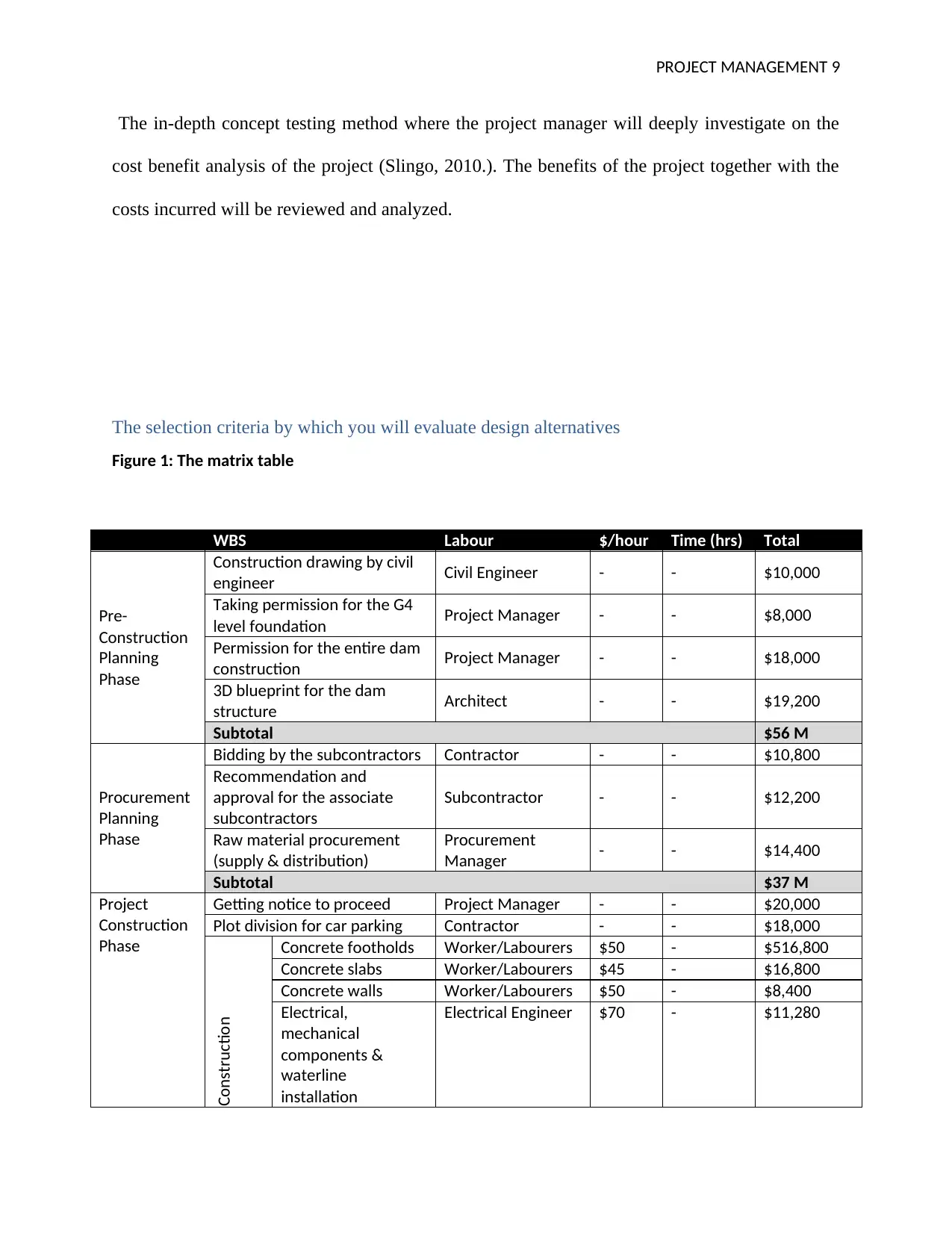
PROJECT MANAGEMENT 9
The in-depth concept testing method where the project manager will deeply investigate on the
cost benefit analysis of the project (Slingo, 2010.). The benefits of the project together with the
costs incurred will be reviewed and analyzed.
The selection criteria by which you will evaluate design alternatives
Figure 1: The matrix table
WBS Labour $/hour Time (hrs) Total
Pre-
Construction
Planning
Phase
Construction drawing by civil
engineer Civil Engineer - - $10,000
Taking permission for the G4
level foundation Project Manager - - $8,000
Permission for the entire dam
construction Project Manager - - $18,000
3D blueprint for the dam
structure Architect - - $19,200
Subtotal $56 M
Procurement
Planning
Phase
Bidding by the subcontractors Contractor - - $10,800
Recommendation and
approval for the associate
subcontractors
Subcontractor - - $12,200
Raw material procurement
(supply & distribution)
Procurement
Manager - - $14,400
Subtotal $37 M
Project
Construction
Phase
Getting notice to proceed Project Manager - - $20,000
Plot division for car parking Contractor - - $18,000
Construction
Concrete footholds Worker/Labourers $50 - $516,800
Concrete slabs Worker/Labourers $45 - $16,800
Concrete walls Worker/Labourers $50 - $8,400
Electrical,
mechanical
components &
waterline
installation
Electrical Engineer $70 - $11,280
The in-depth concept testing method where the project manager will deeply investigate on the
cost benefit analysis of the project (Slingo, 2010.). The benefits of the project together with the
costs incurred will be reviewed and analyzed.
The selection criteria by which you will evaluate design alternatives
Figure 1: The matrix table
WBS Labour $/hour Time (hrs) Total
Pre-
Construction
Planning
Phase
Construction drawing by civil
engineer Civil Engineer - - $10,000
Taking permission for the G4
level foundation Project Manager - - $8,000
Permission for the entire dam
construction Project Manager - - $18,000
3D blueprint for the dam
structure Architect - - $19,200
Subtotal $56 M
Procurement
Planning
Phase
Bidding by the subcontractors Contractor - - $10,800
Recommendation and
approval for the associate
subcontractors
Subcontractor - - $12,200
Raw material procurement
(supply & distribution)
Procurement
Manager - - $14,400
Subtotal $37 M
Project
Construction
Phase
Getting notice to proceed Project Manager - - $20,000
Plot division for car parking Contractor - - $18,000
Construction
Concrete footholds Worker/Labourers $50 - $516,800
Concrete slabs Worker/Labourers $45 - $16,800
Concrete walls Worker/Labourers $50 - $8,400
Electrical,
mechanical
components &
waterline
installation
Electrical Engineer $70 - $11,280
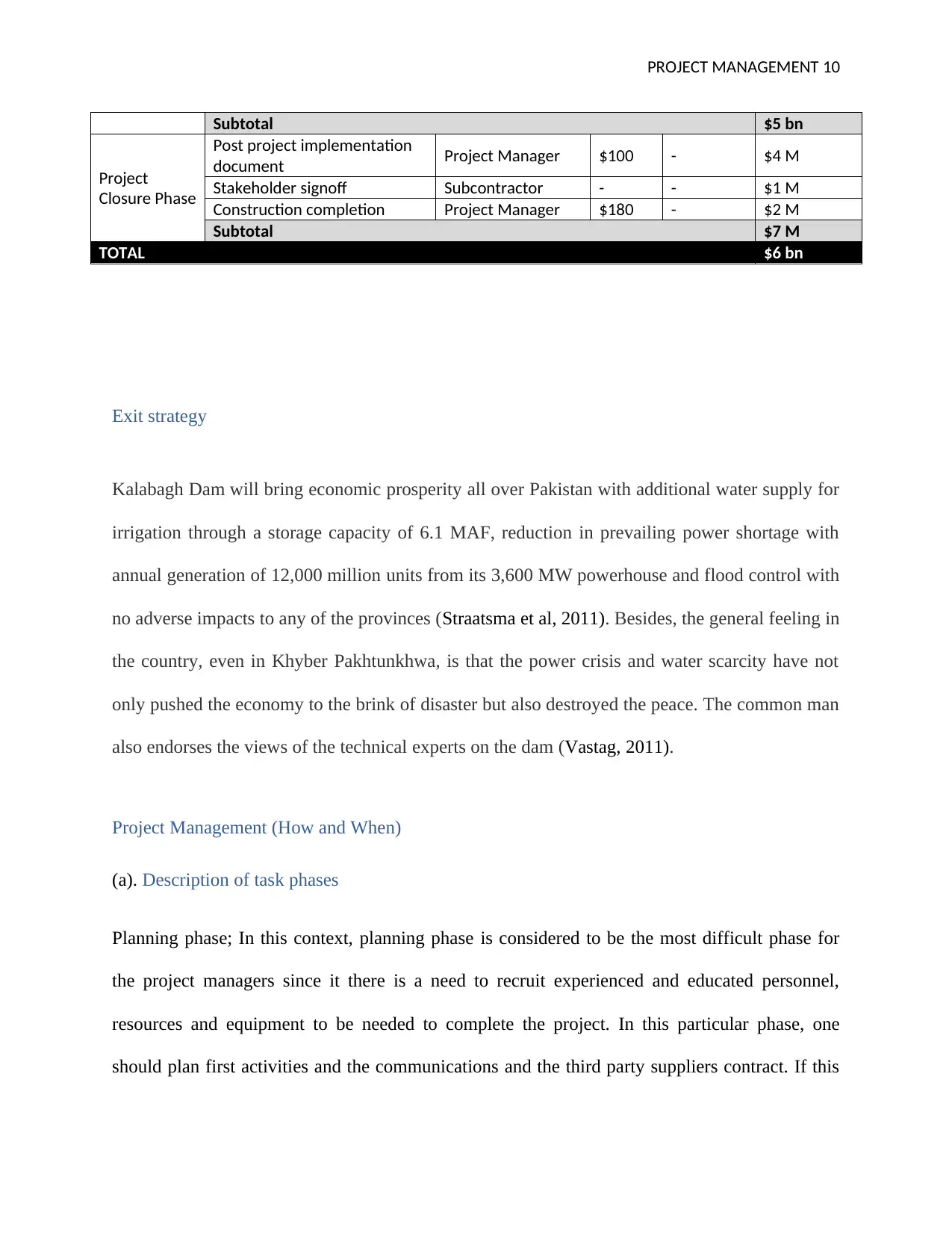
PROJECT MANAGEMENT 10
Subtotal $5 bn
Project
Closure Phase
Post project implementation
document Project Manager $100 - $4 M
Stakeholder signoff Subcontractor - - $1 M
Construction completion Project Manager $180 - $2 M
Subtotal $7 M
TOTAL $6 bn
Exit strategy
Kalabagh Dam will bring economic prosperity all over Pakistan with additional water supply for
irrigation through a storage capacity of 6.1 MAF, reduction in prevailing power shortage with
annual generation of 12,000 million units from its 3,600 MW powerhouse and flood control with
no adverse impacts to any of the provinces (Straatsma et al, 2011). Besides, the general feeling in
the country, even in Khyber Pakhtunkhwa, is that the power crisis and water scarcity have not
only pushed the economy to the brink of disaster but also destroyed the peace. The common man
also endorses the views of the technical experts on the dam (Vastag, 2011).
Project Management (How and When)
(a). Description of task phases
Planning phase; In this context, planning phase is considered to be the most difficult phase for
the project managers since it there is a need to recruit experienced and educated personnel,
resources and equipment to be needed to complete the project. In this particular phase, one
should plan first activities and the communications and the third party suppliers contract. If this
Subtotal $5 bn
Project
Closure Phase
Post project implementation
document Project Manager $100 - $4 M
Stakeholder signoff Subcontractor - - $1 M
Construction completion Project Manager $180 - $2 M
Subtotal $7 M
TOTAL $6 bn
Exit strategy
Kalabagh Dam will bring economic prosperity all over Pakistan with additional water supply for
irrigation through a storage capacity of 6.1 MAF, reduction in prevailing power shortage with
annual generation of 12,000 million units from its 3,600 MW powerhouse and flood control with
no adverse impacts to any of the provinces (Straatsma et al, 2011). Besides, the general feeling in
the country, even in Khyber Pakhtunkhwa, is that the power crisis and water scarcity have not
only pushed the economy to the brink of disaster but also destroyed the peace. The common man
also endorses the views of the technical experts on the dam (Vastag, 2011).
Project Management (How and When)
(a). Description of task phases
Planning phase; In this context, planning phase is considered to be the most difficult phase for
the project managers since it there is a need to recruit experienced and educated personnel,
resources and equipment to be needed to complete the project. In this particular phase, one
should plan first activities and the communications and the third party suppliers contract. If this
Secure Best Marks with AI Grader
Need help grading? Try our AI Grader for instant feedback on your assignments.
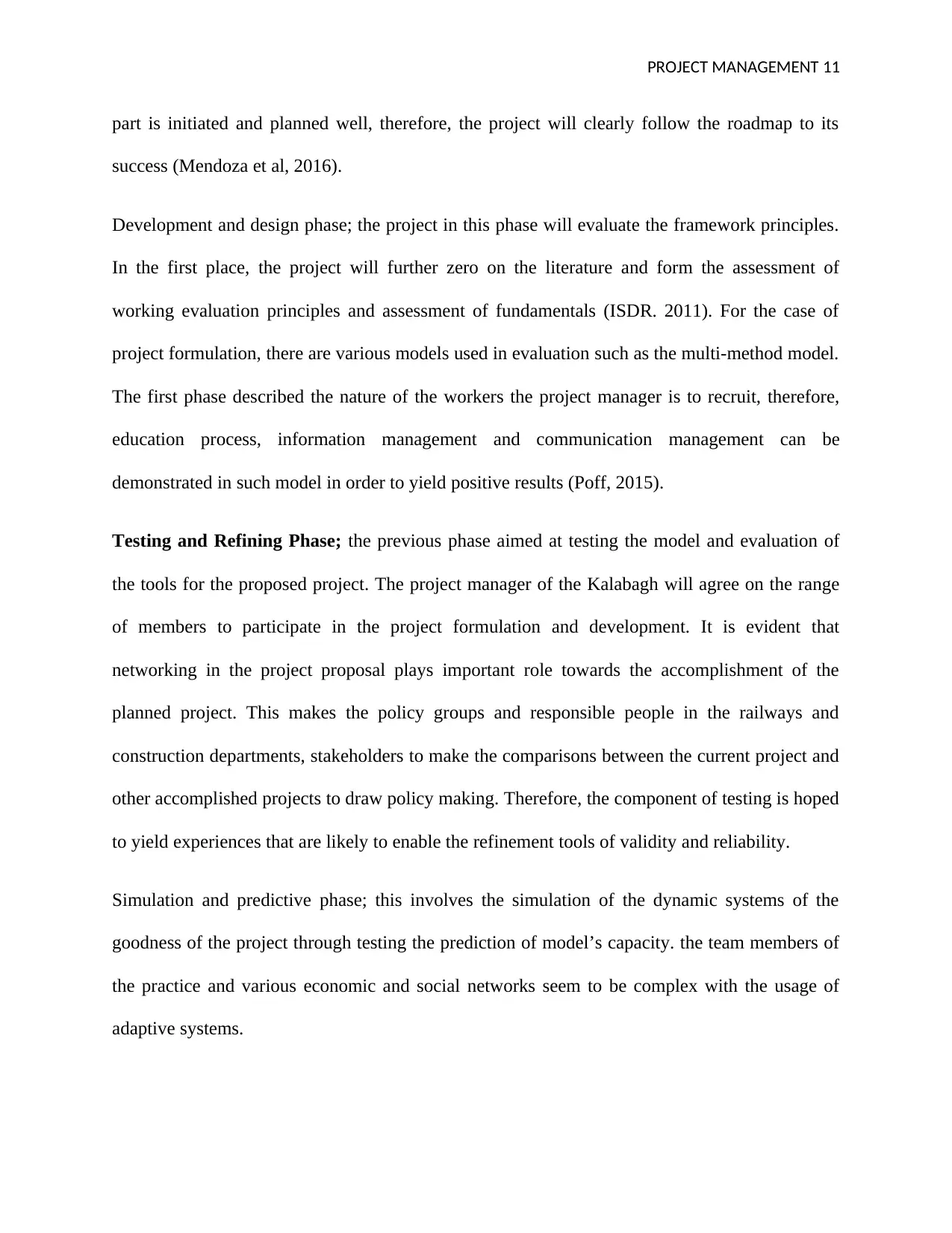
PROJECT MANAGEMENT 11
part is initiated and planned well, therefore, the project will clearly follow the roadmap to its
success (Mendoza et al, 2016).
Development and design phase; the project in this phase will evaluate the framework principles.
In the first place, the project will further zero on the literature and form the assessment of
working evaluation principles and assessment of fundamentals (ISDR. 2011). For the case of
project formulation, there are various models used in evaluation such as the multi-method model.
The first phase described the nature of the workers the project manager is to recruit, therefore,
education process, information management and communication management can be
demonstrated in such model in order to yield positive results (Poff, 2015).
Testing and Refining Phase; the previous phase aimed at testing the model and evaluation of
the tools for the proposed project. The project manager of the Kalabagh will agree on the range
of members to participate in the project formulation and development. It is evident that
networking in the project proposal plays important role towards the accomplishment of the
planned project. This makes the policy groups and responsible people in the railways and
construction departments, stakeholders to make the comparisons between the current project and
other accomplished projects to draw policy making. Therefore, the component of testing is hoped
to yield experiences that are likely to enable the refinement tools of validity and reliability.
Simulation and predictive phase; this involves the simulation of the dynamic systems of the
goodness of the project through testing the prediction of model’s capacity. the team members of
the practice and various economic and social networks seem to be complex with the usage of
adaptive systems.
part is initiated and planned well, therefore, the project will clearly follow the roadmap to its
success (Mendoza et al, 2016).
Development and design phase; the project in this phase will evaluate the framework principles.
In the first place, the project will further zero on the literature and form the assessment of
working evaluation principles and assessment of fundamentals (ISDR. 2011). For the case of
project formulation, there are various models used in evaluation such as the multi-method model.
The first phase described the nature of the workers the project manager is to recruit, therefore,
education process, information management and communication management can be
demonstrated in such model in order to yield positive results (Poff, 2015).
Testing and Refining Phase; the previous phase aimed at testing the model and evaluation of
the tools for the proposed project. The project manager of the Kalabagh will agree on the range
of members to participate in the project formulation and development. It is evident that
networking in the project proposal plays important role towards the accomplishment of the
planned project. This makes the policy groups and responsible people in the railways and
construction departments, stakeholders to make the comparisons between the current project and
other accomplished projects to draw policy making. Therefore, the component of testing is hoped
to yield experiences that are likely to enable the refinement tools of validity and reliability.
Simulation and predictive phase; this involves the simulation of the dynamic systems of the
goodness of the project through testing the prediction of model’s capacity. the team members of
the practice and various economic and social networks seem to be complex with the usage of
adaptive systems.
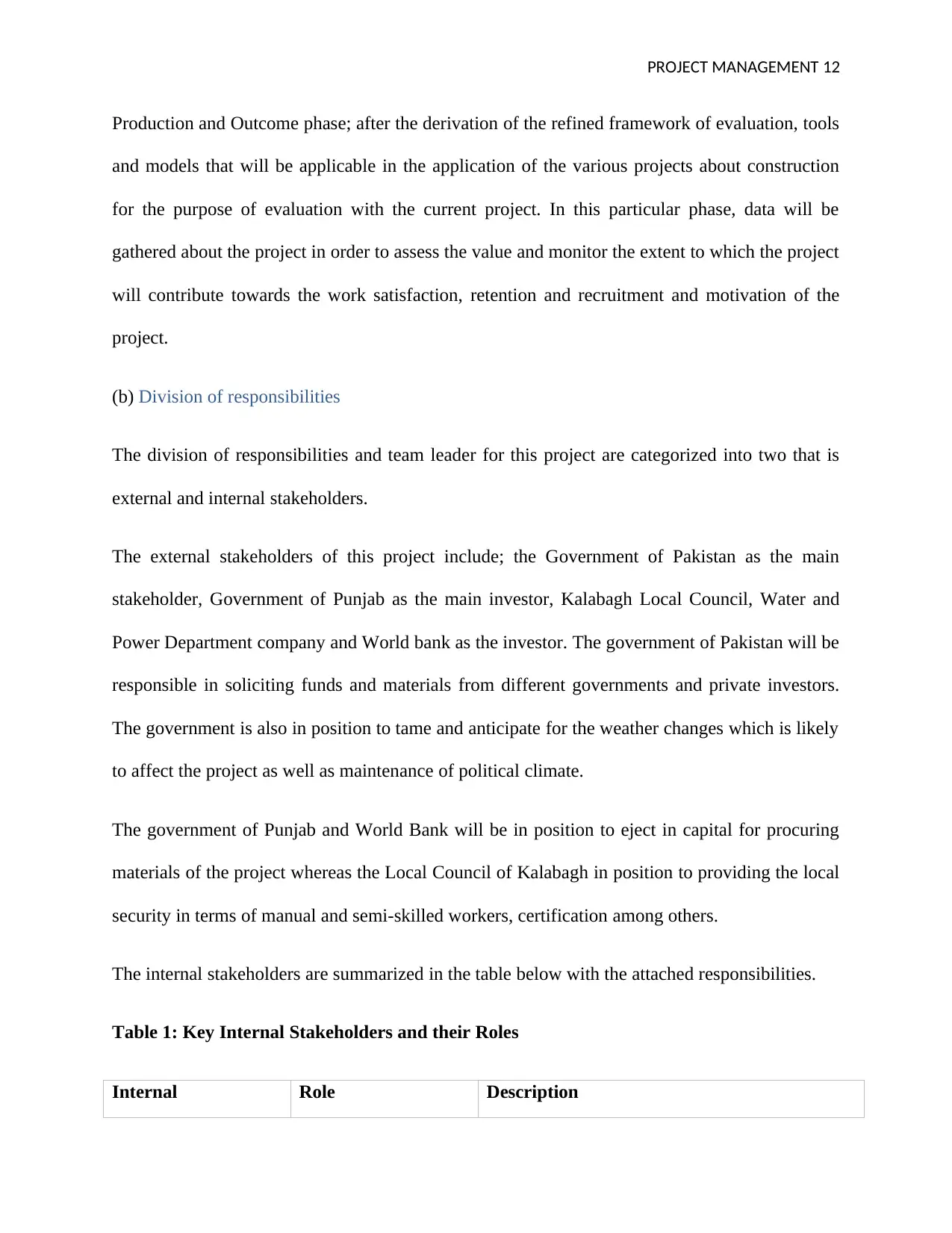
PROJECT MANAGEMENT 12
Production and Outcome phase; after the derivation of the refined framework of evaluation, tools
and models that will be applicable in the application of the various projects about construction
for the purpose of evaluation with the current project. In this particular phase, data will be
gathered about the project in order to assess the value and monitor the extent to which the project
will contribute towards the work satisfaction, retention and recruitment and motivation of the
project.
(b) Division of responsibilities
The division of responsibilities and team leader for this project are categorized into two that is
external and internal stakeholders.
The external stakeholders of this project include; the Government of Pakistan as the main
stakeholder, Government of Punjab as the main investor, Kalabagh Local Council, Water and
Power Department company and World bank as the investor. The government of Pakistan will be
responsible in soliciting funds and materials from different governments and private investors.
The government is also in position to tame and anticipate for the weather changes which is likely
to affect the project as well as maintenance of political climate.
The government of Punjab and World Bank will be in position to eject in capital for procuring
materials of the project whereas the Local Council of Kalabagh in position to providing the local
security in terms of manual and semi-skilled workers, certification among others.
The internal stakeholders are summarized in the table below with the attached responsibilities.
Table 1: Key Internal Stakeholders and their Roles
Internal Role Description
Production and Outcome phase; after the derivation of the refined framework of evaluation, tools
and models that will be applicable in the application of the various projects about construction
for the purpose of evaluation with the current project. In this particular phase, data will be
gathered about the project in order to assess the value and monitor the extent to which the project
will contribute towards the work satisfaction, retention and recruitment and motivation of the
project.
(b) Division of responsibilities
The division of responsibilities and team leader for this project are categorized into two that is
external and internal stakeholders.
The external stakeholders of this project include; the Government of Pakistan as the main
stakeholder, Government of Punjab as the main investor, Kalabagh Local Council, Water and
Power Department company and World bank as the investor. The government of Pakistan will be
responsible in soliciting funds and materials from different governments and private investors.
The government is also in position to tame and anticipate for the weather changes which is likely
to affect the project as well as maintenance of political climate.
The government of Punjab and World Bank will be in position to eject in capital for procuring
materials of the project whereas the Local Council of Kalabagh in position to providing the local
security in terms of manual and semi-skilled workers, certification among others.
The internal stakeholders are summarized in the table below with the attached responsibilities.
Table 1: Key Internal Stakeholders and their Roles
Internal Role Description
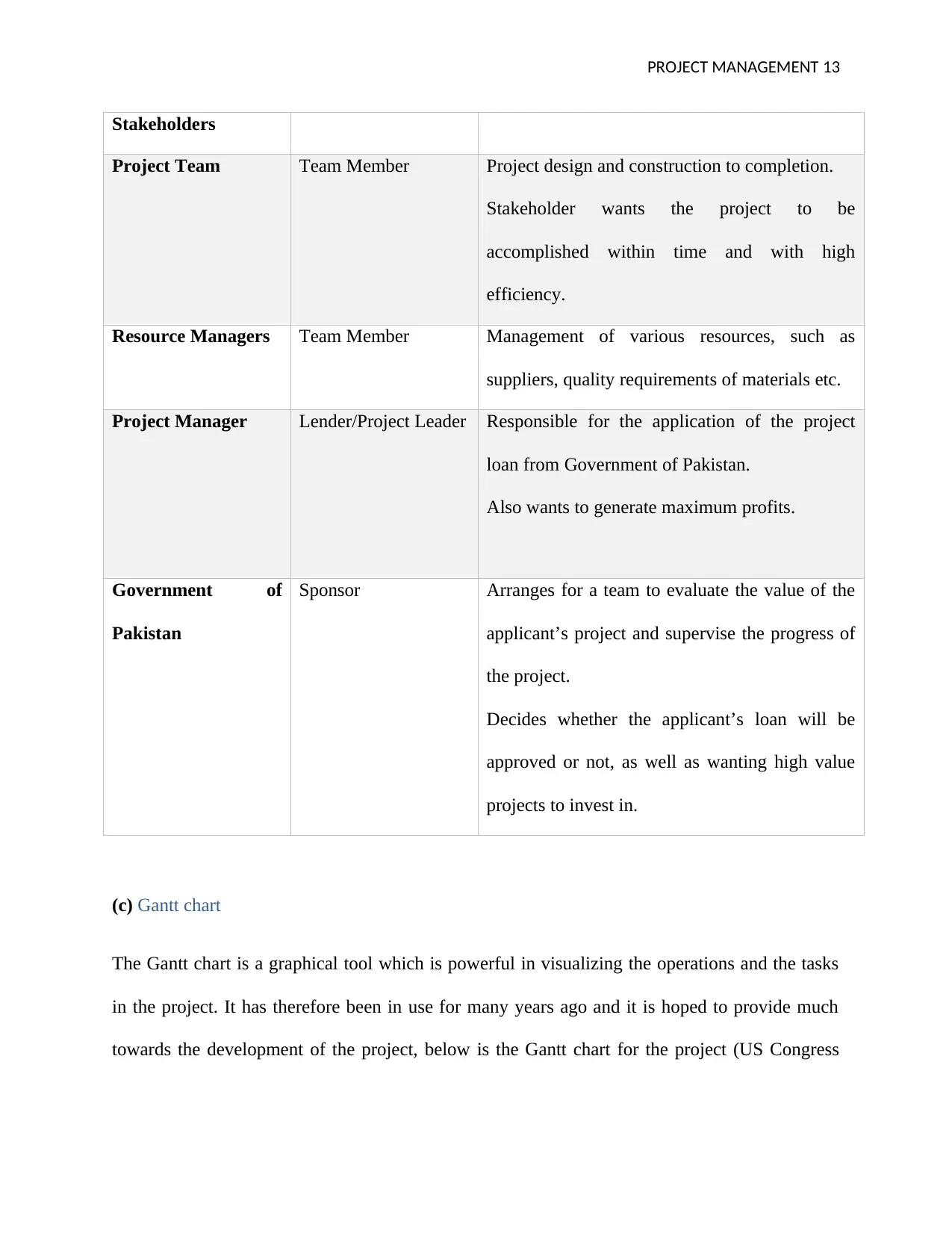
PROJECT MANAGEMENT 13
Stakeholders
Project Team Team Member Project design and construction to completion.
Stakeholder wants the project to be
accomplished within time and with high
efficiency.
Resource Managers Team Member Management of various resources, such as
suppliers, quality requirements of materials etc.
Project Manager Lender/Project Leader Responsible for the application of the project
loan from Government of Pakistan.
Also wants to generate maximum profits.
Government of
Pakistan
Sponsor Arranges for a team to evaluate the value of the
applicant’s project and supervise the progress of
the project.
Decides whether the applicant’s loan will be
approved or not, as well as wanting high value
projects to invest in.
(c) Gantt chart
The Gantt chart is a graphical tool which is powerful in visualizing the operations and the tasks
in the project. It has therefore been in use for many years ago and it is hoped to provide much
towards the development of the project, below is the Gantt chart for the project (US Congress
Stakeholders
Project Team Team Member Project design and construction to completion.
Stakeholder wants the project to be
accomplished within time and with high
efficiency.
Resource Managers Team Member Management of various resources, such as
suppliers, quality requirements of materials etc.
Project Manager Lender/Project Leader Responsible for the application of the project
loan from Government of Pakistan.
Also wants to generate maximum profits.
Government of
Pakistan
Sponsor Arranges for a team to evaluate the value of the
applicant’s project and supervise the progress of
the project.
Decides whether the applicant’s loan will be
approved or not, as well as wanting high value
projects to invest in.
(c) Gantt chart
The Gantt chart is a graphical tool which is powerful in visualizing the operations and the tasks
in the project. It has therefore been in use for many years ago and it is hoped to provide much
towards the development of the project, below is the Gantt chart for the project (US Congress
Paraphrase This Document
Need a fresh take? Get an instant paraphrase of this document with our AI Paraphraser
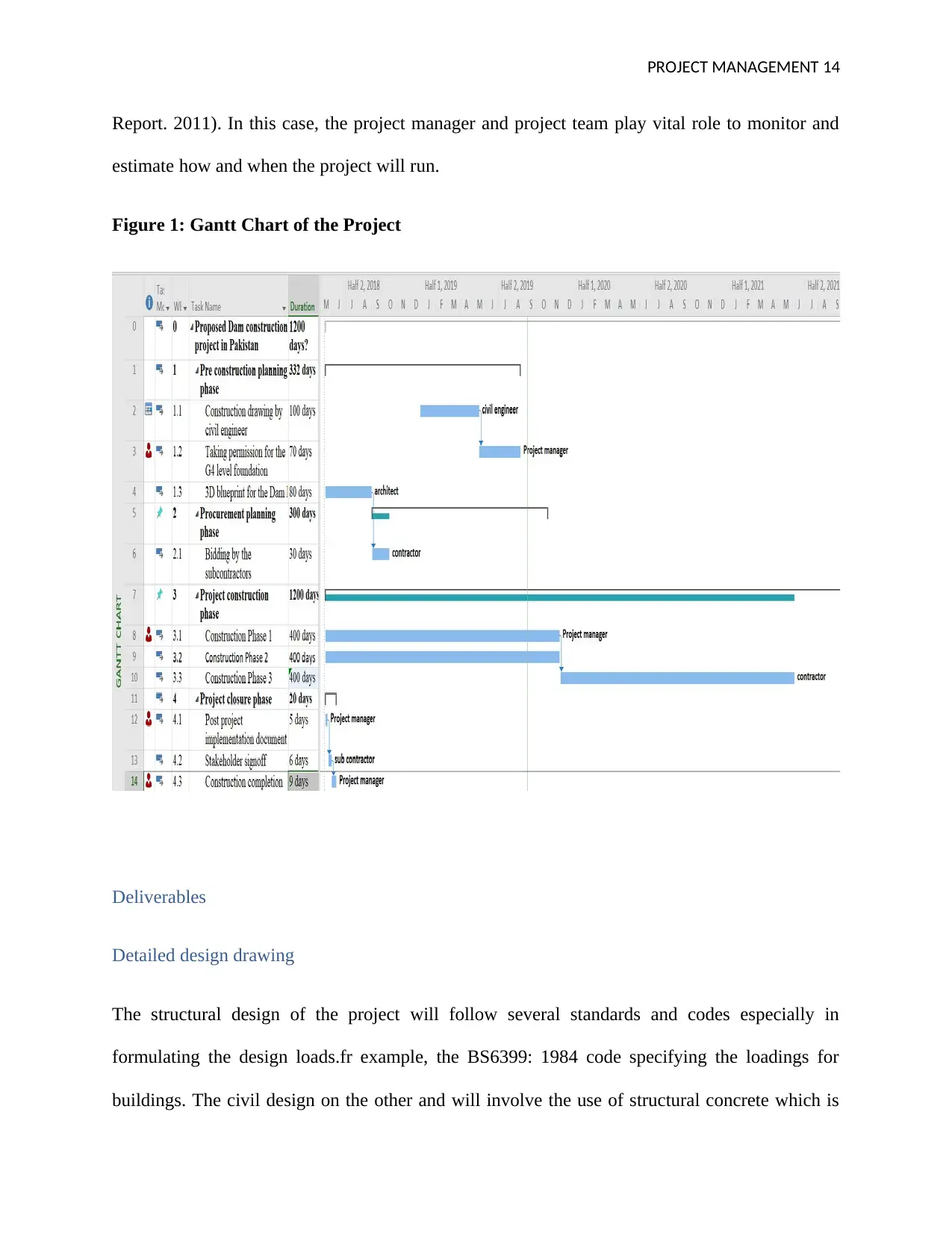
PROJECT MANAGEMENT 14
Report. 2011). In this case, the project manager and project team play vital role to monitor and
estimate how and when the project will run.
Figure 1: Gantt Chart of the Project
Deliverables
Detailed design drawing
The structural design of the project will follow several standards and codes especially in
formulating the design loads.fr example, the BS6399: 1984 code specifying the loadings for
buildings. The civil design on the other and will involve the use of structural concrete which is
Report. 2011). In this case, the project manager and project team play vital role to monitor and
estimate how and when the project will run.
Figure 1: Gantt Chart of the Project
Deliverables
Detailed design drawing
The structural design of the project will follow several standards and codes especially in
formulating the design loads.fr example, the BS6399: 1984 code specifying the loadings for
buildings. The civil design on the other and will involve the use of structural concrete which is
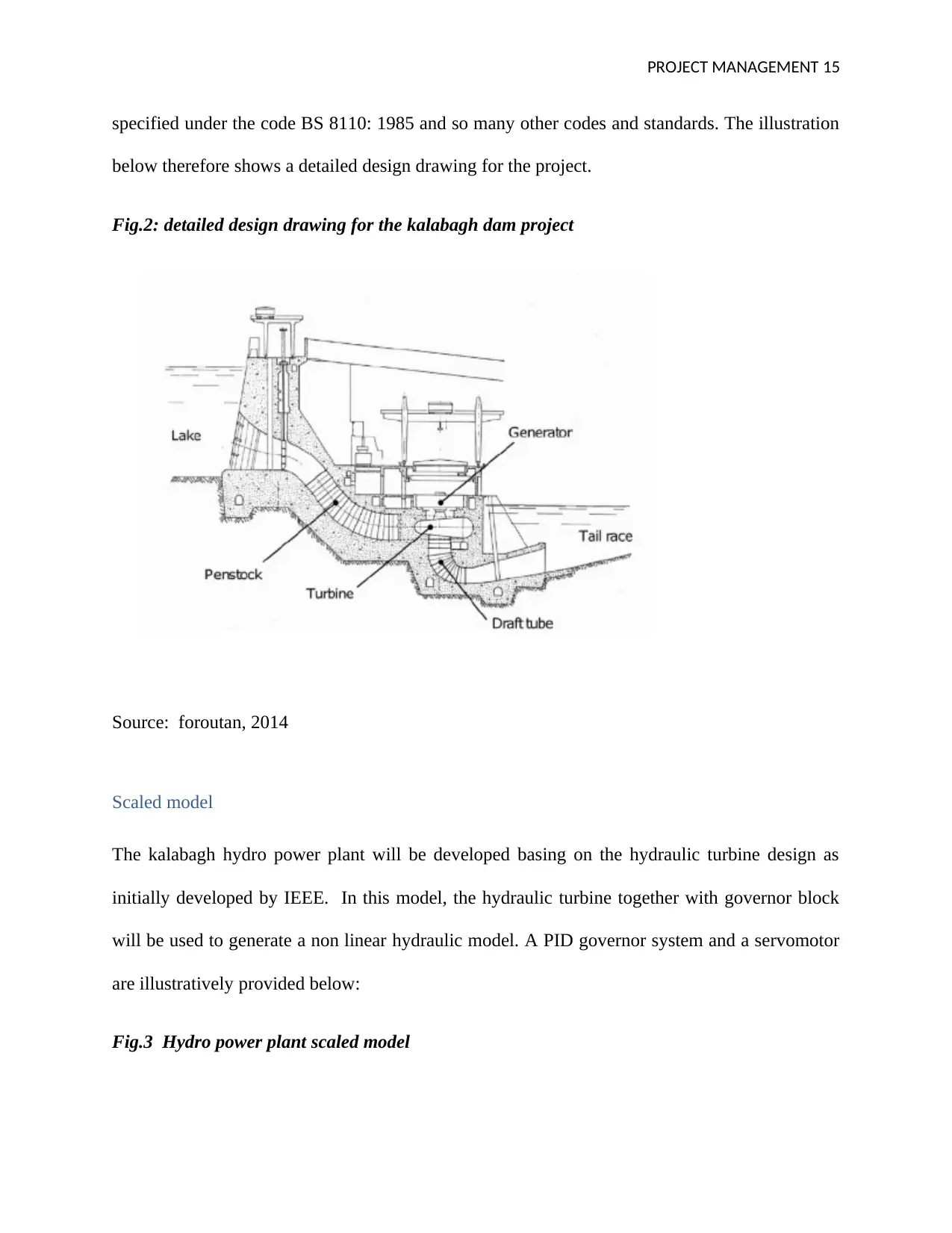
PROJECT MANAGEMENT 15
specified under the code BS 8110: 1985 and so many other codes and standards. The illustration
below therefore shows a detailed design drawing for the project.
Fig.2: detailed design drawing for the kalabagh dam project
Source: foroutan, 2014
Scaled model
The kalabagh hydro power plant will be developed basing on the hydraulic turbine design as
initially developed by IEEE. In this model, the hydraulic turbine together with governor block
will be used to generate a non linear hydraulic model. A PID governor system and a servomotor
are illustratively provided below:
Fig.3 Hydro power plant scaled model
specified under the code BS 8110: 1985 and so many other codes and standards. The illustration
below therefore shows a detailed design drawing for the project.
Fig.2: detailed design drawing for the kalabagh dam project
Source: foroutan, 2014
Scaled model
The kalabagh hydro power plant will be developed basing on the hydraulic turbine design as
initially developed by IEEE. In this model, the hydraulic turbine together with governor block
will be used to generate a non linear hydraulic model. A PID governor system and a servomotor
are illustratively provided below:
Fig.3 Hydro power plant scaled model
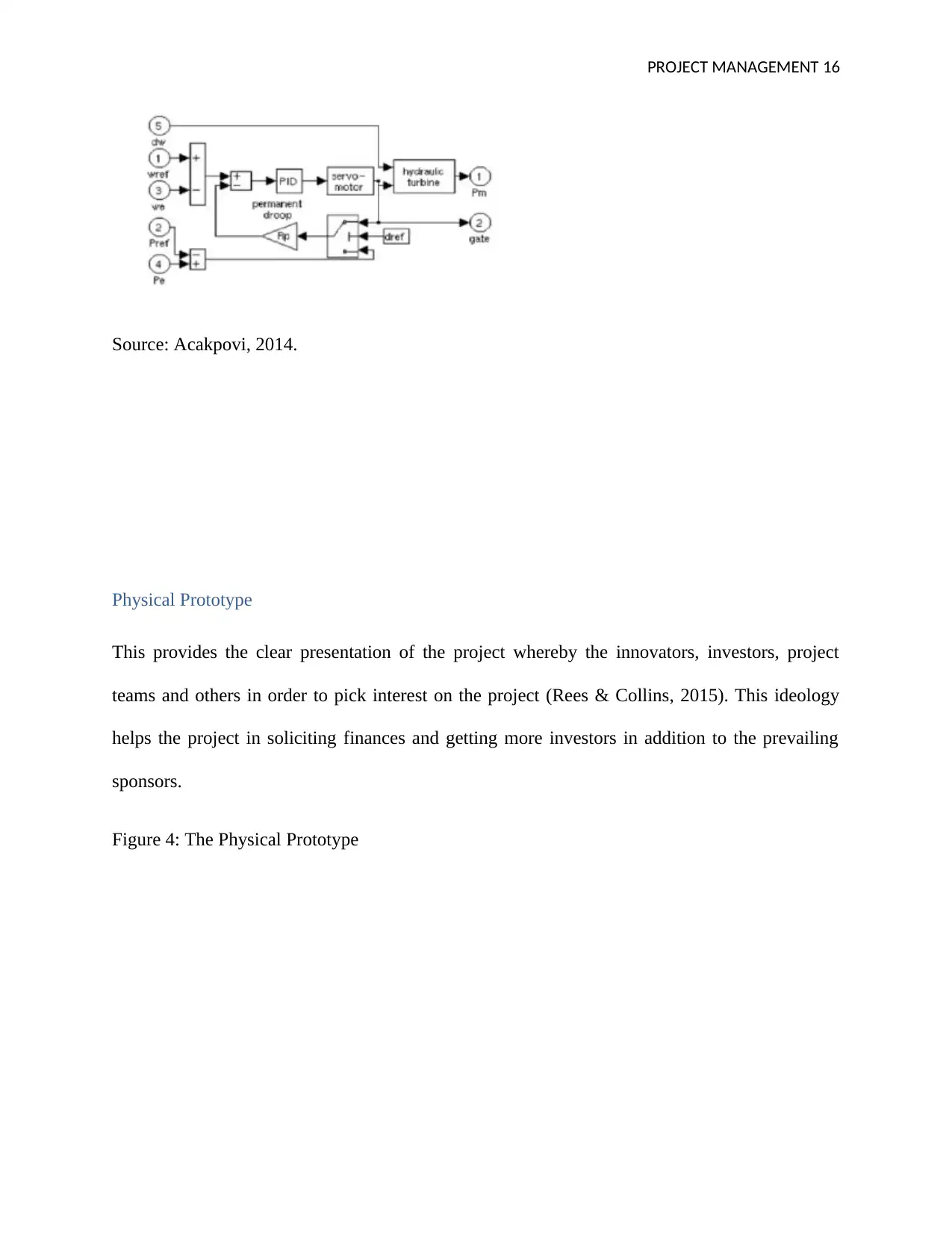
PROJECT MANAGEMENT 16
Source: Acakpovi, 2014.
Physical Prototype
This provides the clear presentation of the project whereby the innovators, investors, project
teams and others in order to pick interest on the project (Rees & Collins, 2015). This ideology
helps the project in soliciting finances and getting more investors in addition to the prevailing
sponsors.
Figure 4: The Physical Prototype
Source: Acakpovi, 2014.
Physical Prototype
This provides the clear presentation of the project whereby the innovators, investors, project
teams and others in order to pick interest on the project (Rees & Collins, 2015). This ideology
helps the project in soliciting finances and getting more investors in addition to the prevailing
sponsors.
Figure 4: The Physical Prototype
Secure Best Marks with AI Grader
Need help grading? Try our AI Grader for instant feedback on your assignments.
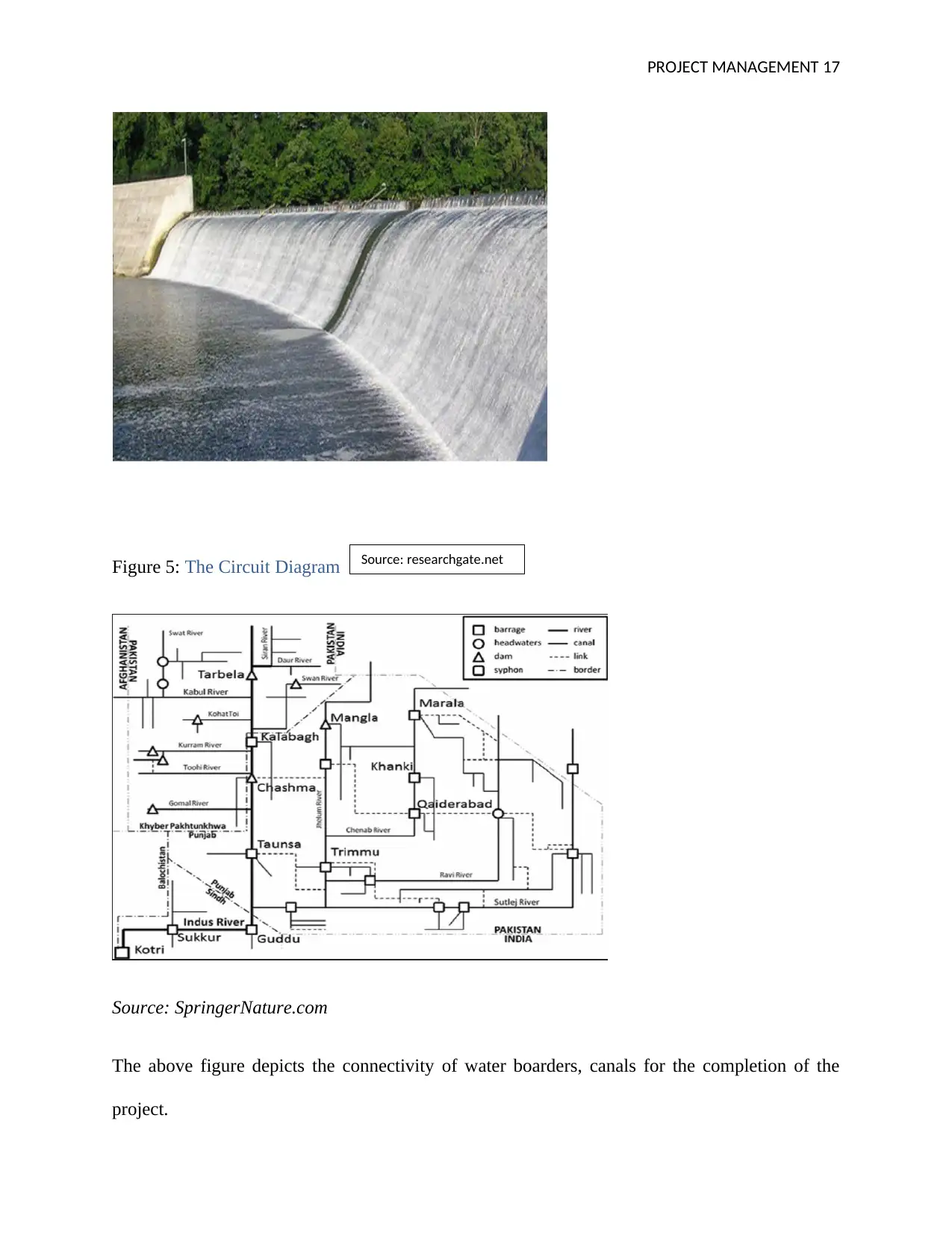
PROJECT MANAGEMENT 17
Figure 5: The Circuit Diagram
Source: SpringerNature.com
The above figure depicts the connectivity of water boarders, canals for the completion of the
project.
Source: researchgate.net
Figure 5: The Circuit Diagram
Source: SpringerNature.com
The above figure depicts the connectivity of water boarders, canals for the completion of the
project.
Source: researchgate.net
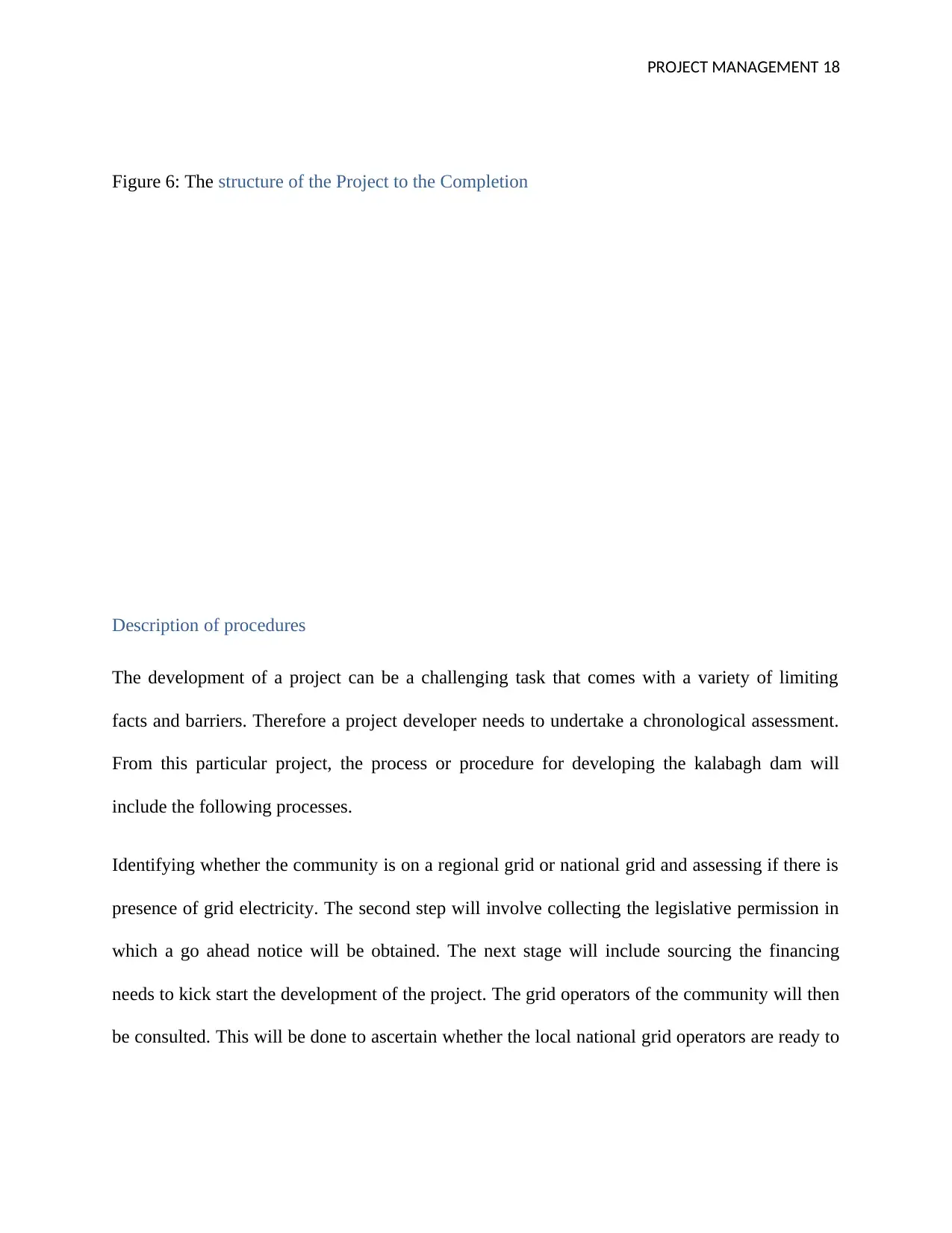
PROJECT MANAGEMENT 18
Figure 6: The structure of the Project to the Completion
Description of procedures
The development of a project can be a challenging task that comes with a variety of limiting
facts and barriers. Therefore a project developer needs to undertake a chronological assessment.
From this particular project, the process or procedure for developing the kalabagh dam will
include the following processes.
Identifying whether the community is on a regional grid or national grid and assessing if there is
presence of grid electricity. The second step will involve collecting the legislative permission in
which a go ahead notice will be obtained. The next stage will include sourcing the financing
needs to kick start the development of the project. The grid operators of the community will then
be consulted. This will be done to ascertain whether the local national grid operators are ready to
PrepareDrawingsSubcontractorsLabourhiringStakeholdersignoff
Figure 6: The structure of the Project to the Completion
Description of procedures
The development of a project can be a challenging task that comes with a variety of limiting
facts and barriers. Therefore a project developer needs to undertake a chronological assessment.
From this particular project, the process or procedure for developing the kalabagh dam will
include the following processes.
Identifying whether the community is on a regional grid or national grid and assessing if there is
presence of grid electricity. The second step will involve collecting the legislative permission in
which a go ahead notice will be obtained. The next stage will include sourcing the financing
needs to kick start the development of the project. The grid operators of the community will then
be consulted. This will be done to ascertain whether the local national grid operators are ready to
PrepareDrawingsSubcontractorsLabourhiringStakeholdersignoff
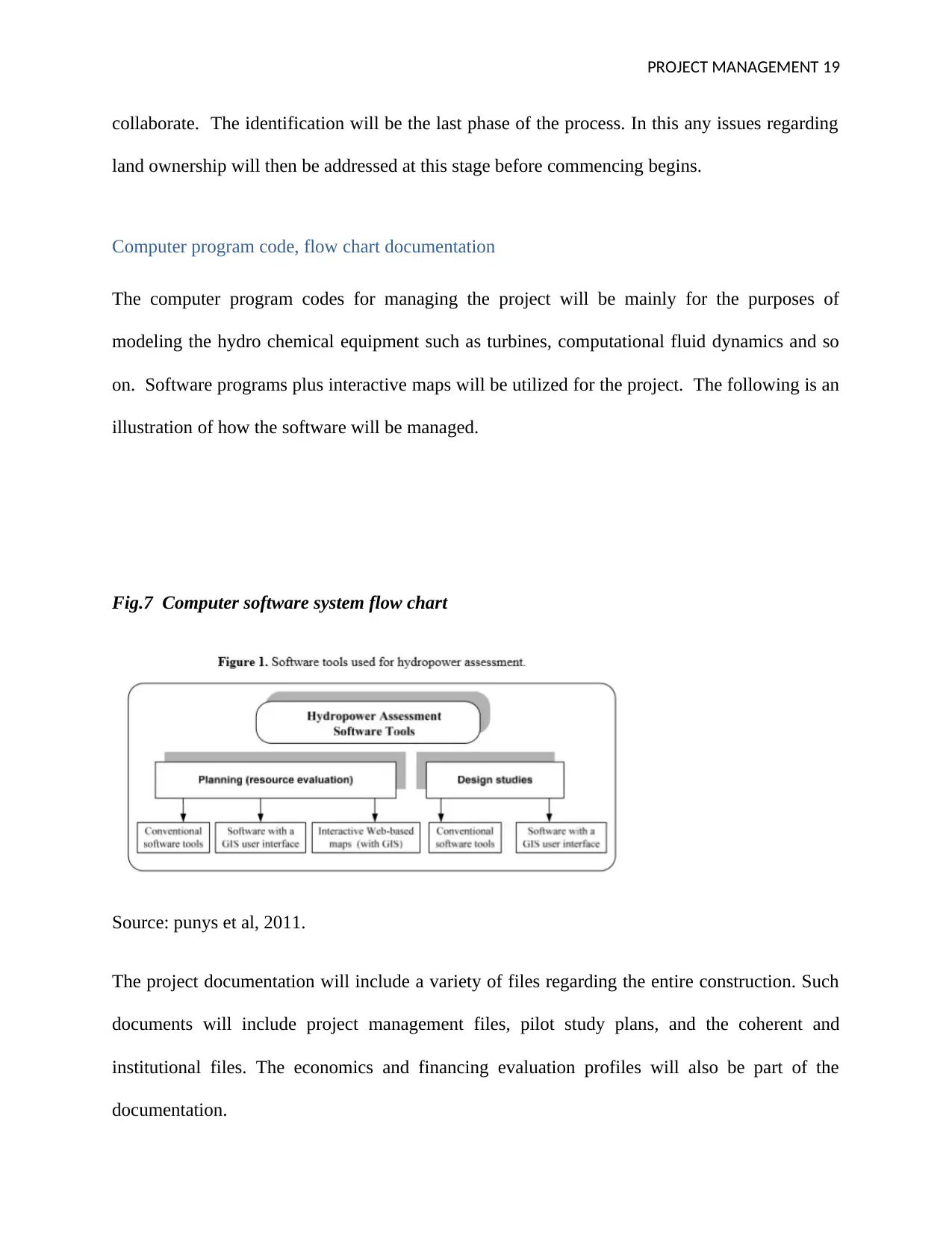
PROJECT MANAGEMENT 19
collaborate. The identification will be the last phase of the process. In this any issues regarding
land ownership will then be addressed at this stage before commencing begins.
Computer program code, flow chart documentation
The computer program codes for managing the project will be mainly for the purposes of
modeling the hydro chemical equipment such as turbines, computational fluid dynamics and so
on. Software programs plus interactive maps will be utilized for the project. The following is an
illustration of how the software will be managed.
Fig.7 Computer software system flow chart
Source: punys et al, 2011.
The project documentation will include a variety of files regarding the entire construction. Such
documents will include project management files, pilot study plans, and the coherent and
institutional files. The economics and financing evaluation profiles will also be part of the
documentation.
collaborate. The identification will be the last phase of the process. In this any issues regarding
land ownership will then be addressed at this stage before commencing begins.
Computer program code, flow chart documentation
The computer program codes for managing the project will be mainly for the purposes of
modeling the hydro chemical equipment such as turbines, computational fluid dynamics and so
on. Software programs plus interactive maps will be utilized for the project. The following is an
illustration of how the software will be managed.
Fig.7 Computer software system flow chart
Source: punys et al, 2011.
The project documentation will include a variety of files regarding the entire construction. Such
documents will include project management files, pilot study plans, and the coherent and
institutional files. The economics and financing evaluation profiles will also be part of the
documentation.
Paraphrase This Document
Need a fresh take? Get an instant paraphrase of this document with our AI Paraphraser
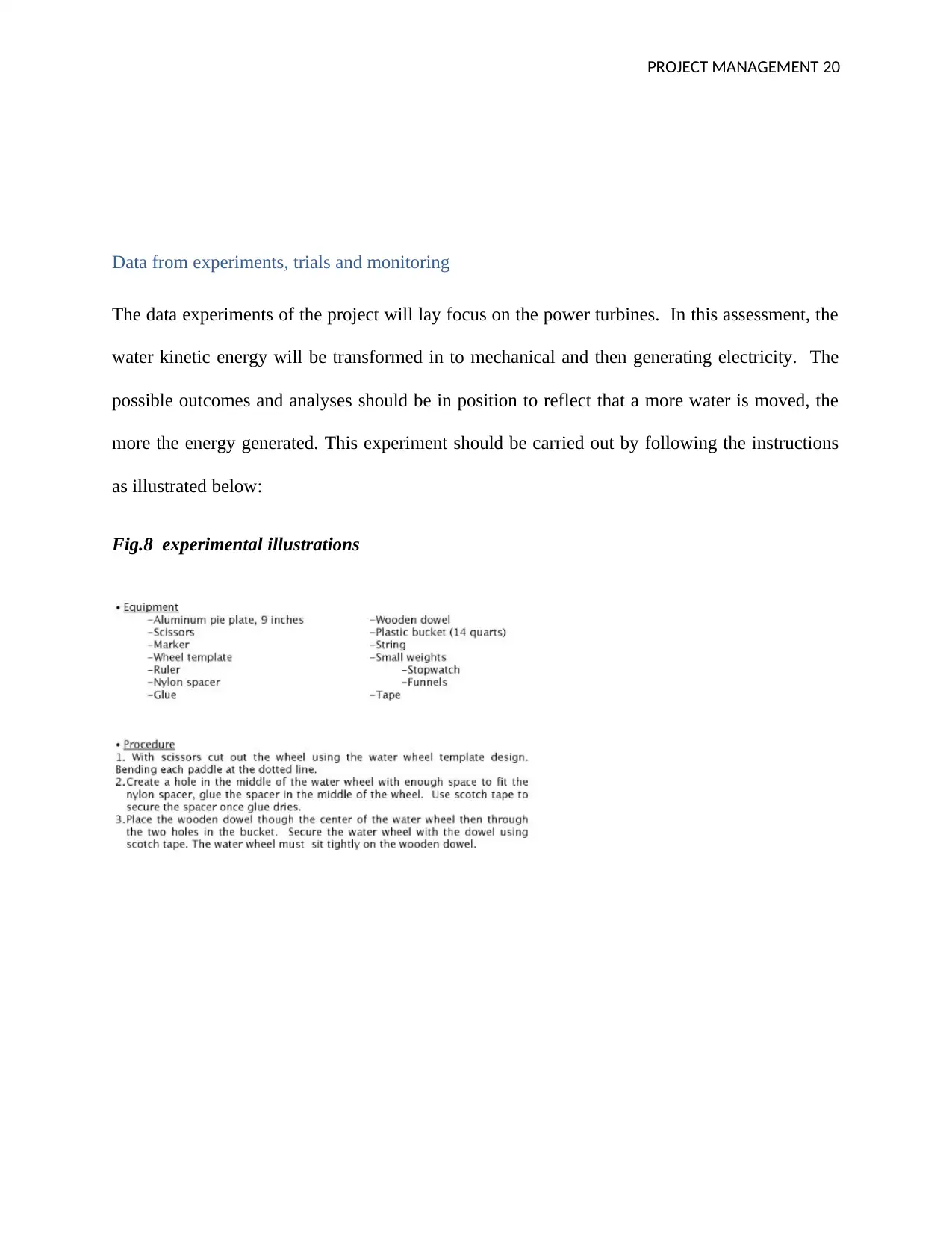
PROJECT MANAGEMENT 20
Data from experiments, trials and monitoring
The data experiments of the project will lay focus on the power turbines. In this assessment, the
water kinetic energy will be transformed in to mechanical and then generating electricity. The
possible outcomes and analyses should be in position to reflect that a more water is moved, the
more the energy generated. This experiment should be carried out by following the instructions
as illustrated below:
Fig.8 experimental illustrations
Data from experiments, trials and monitoring
The data experiments of the project will lay focus on the power turbines. In this assessment, the
water kinetic energy will be transformed in to mechanical and then generating electricity. The
possible outcomes and analyses should be in position to reflect that a more water is moved, the
more the energy generated. This experiment should be carried out by following the instructions
as illustrated below:
Fig.8 experimental illustrations
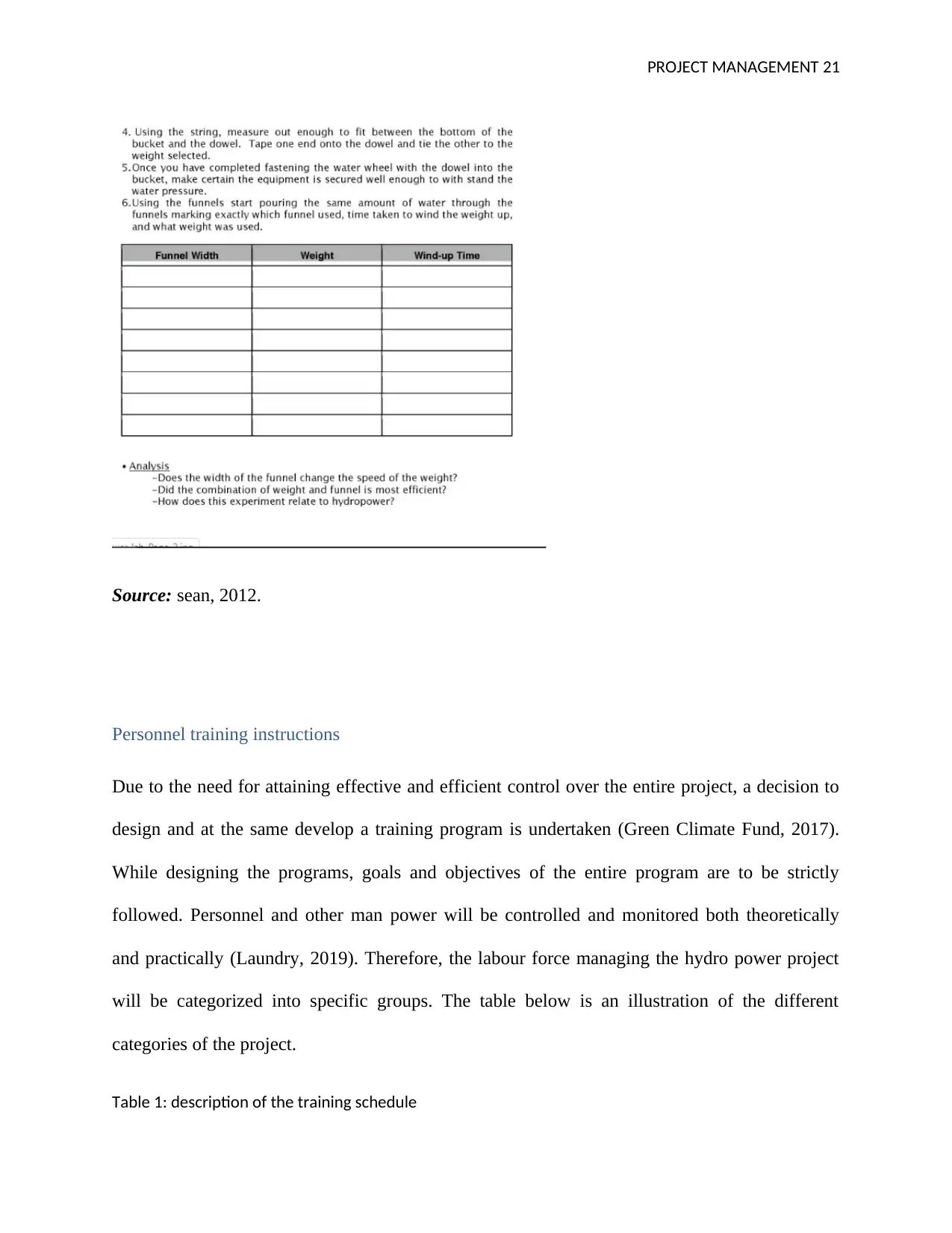
PROJECT MANAGEMENT 21
Source: sean, 2012.
Personnel training instructions
Due to the need for attaining effective and efficient control over the entire project, a decision to
design and at the same develop a training program is undertaken (Green Climate Fund, 2017).
While designing the programs, goals and objectives of the entire program are to be strictly
followed. Personnel and other man power will be controlled and monitored both theoretically
and practically (Laundry, 2019). Therefore, the labour force managing the hydro power project
will be categorized into specific groups. The table below is an illustration of the different
categories of the project.
Table 1: description of the training schedule
Source: sean, 2012.
Personnel training instructions
Due to the need for attaining effective and efficient control over the entire project, a decision to
design and at the same develop a training program is undertaken (Green Climate Fund, 2017).
While designing the programs, goals and objectives of the entire program are to be strictly
followed. Personnel and other man power will be controlled and monitored both theoretically
and practically (Laundry, 2019). Therefore, the labour force managing the hydro power project
will be categorized into specific groups. The table below is an illustration of the different
categories of the project.
Table 1: description of the training schedule
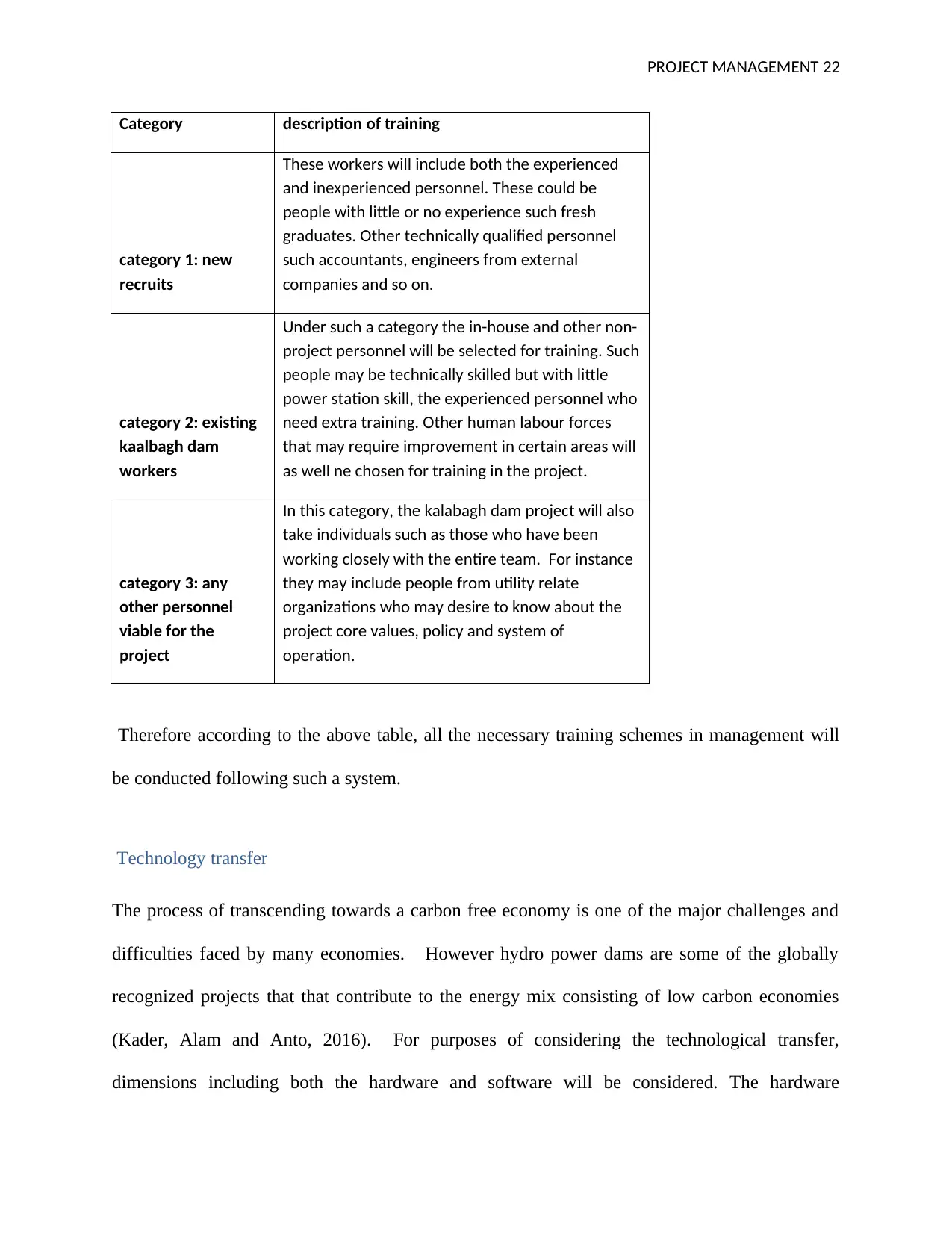
PROJECT MANAGEMENT 22
Category description of training
category 1: new
recruits
These workers will include both the experienced
and inexperienced personnel. These could be
people with little or no experience such fresh
graduates. Other technically qualified personnel
such accountants, engineers from external
companies and so on.
category 2: existing
kaalbagh dam
workers
Under such a category the in-house and other non-
project personnel will be selected for training. Such
people may be technically skilled but with little
power station skill, the experienced personnel who
need extra training. Other human labour forces
that may require improvement in certain areas will
as well ne chosen for training in the project.
category 3: any
other personnel
viable for the
project
In this category, the kalabagh dam project will also
take individuals such as those who have been
working closely with the entire team. For instance
they may include people from utility relate
organizations who may desire to know about the
project core values, policy and system of
operation.
Therefore according to the above table, all the necessary training schemes in management will
be conducted following such a system.
Technology transfer
The process of transcending towards a carbon free economy is one of the major challenges and
difficulties faced by many economies. However hydro power dams are some of the globally
recognized projects that that contribute to the energy mix consisting of low carbon economies
(Kader, Alam and Anto, 2016). For purposes of considering the technological transfer,
dimensions including both the hardware and software will be considered. The hardware
Category description of training
category 1: new
recruits
These workers will include both the experienced
and inexperienced personnel. These could be
people with little or no experience such fresh
graduates. Other technically qualified personnel
such accountants, engineers from external
companies and so on.
category 2: existing
kaalbagh dam
workers
Under such a category the in-house and other non-
project personnel will be selected for training. Such
people may be technically skilled but with little
power station skill, the experienced personnel who
need extra training. Other human labour forces
that may require improvement in certain areas will
as well ne chosen for training in the project.
category 3: any
other personnel
viable for the
project
In this category, the kalabagh dam project will also
take individuals such as those who have been
working closely with the entire team. For instance
they may include people from utility relate
organizations who may desire to know about the
project core values, policy and system of
operation.
Therefore according to the above table, all the necessary training schemes in management will
be conducted following such a system.
Technology transfer
The process of transcending towards a carbon free economy is one of the major challenges and
difficulties faced by many economies. However hydro power dams are some of the globally
recognized projects that that contribute to the energy mix consisting of low carbon economies
(Kader, Alam and Anto, 2016). For purposes of considering the technological transfer,
dimensions including both the hardware and software will be considered. The hardware
Secure Best Marks with AI Grader
Need help grading? Try our AI Grader for instant feedback on your assignments.
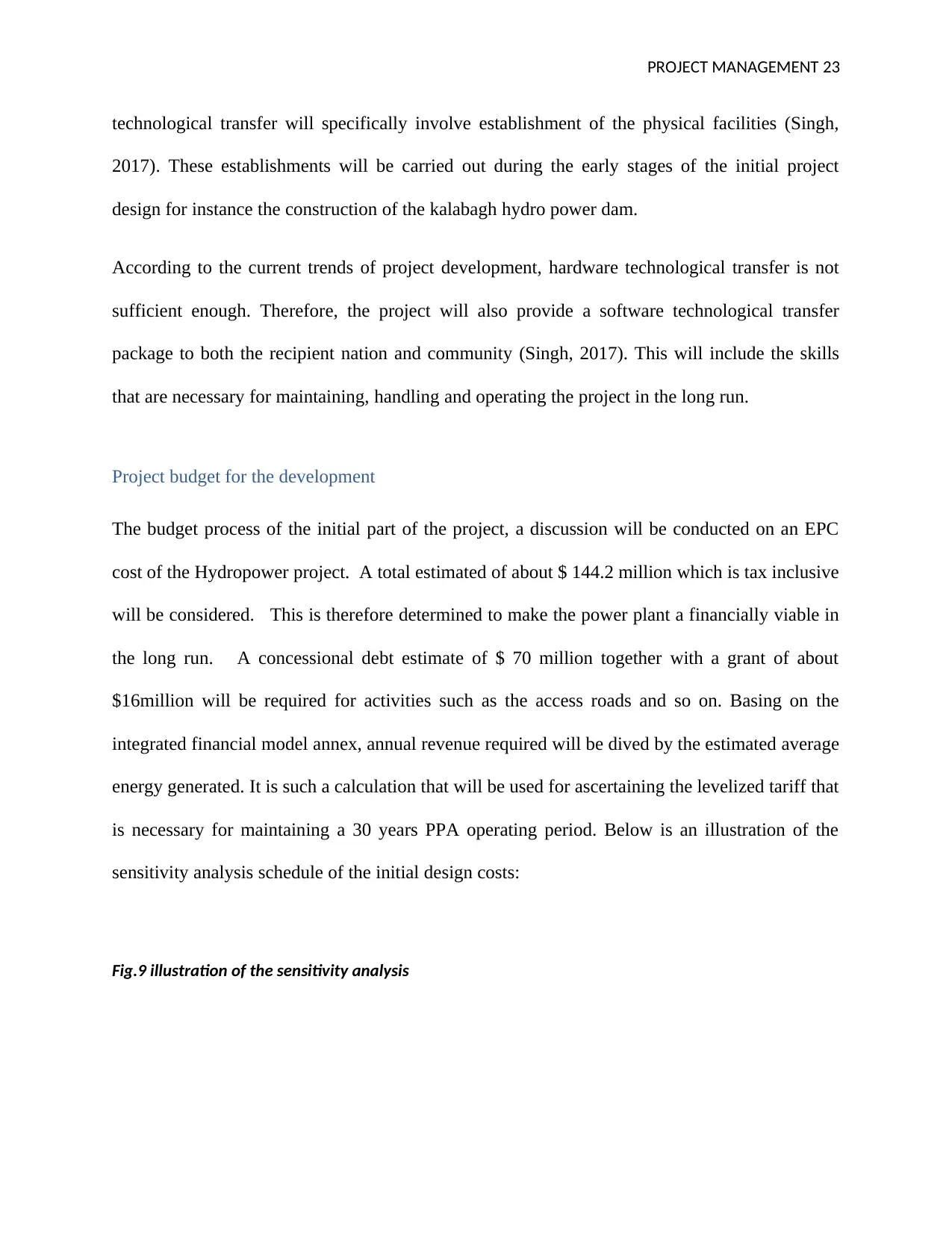
PROJECT MANAGEMENT 23
technological transfer will specifically involve establishment of the physical facilities (Singh,
2017). These establishments will be carried out during the early stages of the initial project
design for instance the construction of the kalabagh hydro power dam.
According to the current trends of project development, hardware technological transfer is not
sufficient enough. Therefore, the project will also provide a software technological transfer
package to both the recipient nation and community (Singh, 2017). This will include the skills
that are necessary for maintaining, handling and operating the project in the long run.
Project budget for the development
The budget process of the initial part of the project, a discussion will be conducted on an EPC
cost of the Hydropower project. A total estimated of about $ 144.2 million which is tax inclusive
will be considered. This is therefore determined to make the power plant a financially viable in
the long run. A concessional debt estimate of $ 70 million together with a grant of about
$16million will be required for activities such as the access roads and so on. Basing on the
integrated financial model annex, annual revenue required will be dived by the estimated average
energy generated. It is such a calculation that will be used for ascertaining the levelized tariff that
is necessary for maintaining a 30 years PPA operating period. Below is an illustration of the
sensitivity analysis schedule of the initial design costs:
Fig.9 illustration of the sensitivity analysis
technological transfer will specifically involve establishment of the physical facilities (Singh,
2017). These establishments will be carried out during the early stages of the initial project
design for instance the construction of the kalabagh hydro power dam.
According to the current trends of project development, hardware technological transfer is not
sufficient enough. Therefore, the project will also provide a software technological transfer
package to both the recipient nation and community (Singh, 2017). This will include the skills
that are necessary for maintaining, handling and operating the project in the long run.
Project budget for the development
The budget process of the initial part of the project, a discussion will be conducted on an EPC
cost of the Hydropower project. A total estimated of about $ 144.2 million which is tax inclusive
will be considered. This is therefore determined to make the power plant a financially viable in
the long run. A concessional debt estimate of $ 70 million together with a grant of about
$16million will be required for activities such as the access roads and so on. Basing on the
integrated financial model annex, annual revenue required will be dived by the estimated average
energy generated. It is such a calculation that will be used for ascertaining the levelized tariff that
is necessary for maintaining a 30 years PPA operating period. Below is an illustration of the
sensitivity analysis schedule of the initial design costs:
Fig.9 illustration of the sensitivity analysis
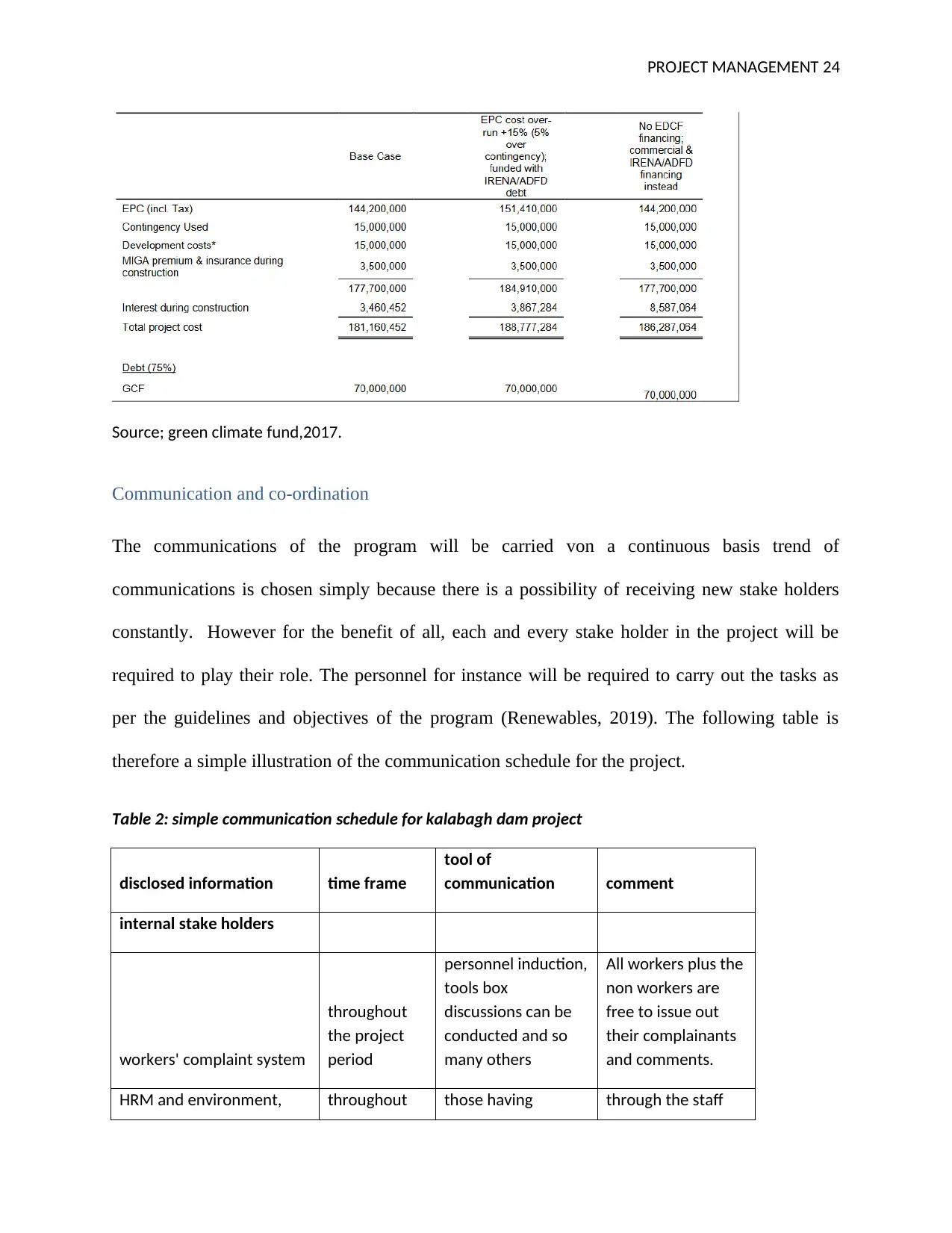
PROJECT MANAGEMENT 24
Source; green climate fund,2017.
Communication and co-ordination
The communications of the program will be carried von a continuous basis trend of
communications is chosen simply because there is a possibility of receiving new stake holders
constantly. However for the benefit of all, each and every stake holder in the project will be
required to play their role. The personnel for instance will be required to carry out the tasks as
per the guidelines and objectives of the program (Renewables, 2019). The following table is
therefore a simple illustration of the communication schedule for the project.
Table 2: simple communication schedule for kalabagh dam project
disclosed information time frame
tool of
communication comment
internal stake holders
workers' complaint system
throughout
the project
period
personnel induction,
tools box
discussions can be
conducted and so
many others
All workers plus the
non workers are
free to issue out
their complainants
and comments.
HRM and environment, throughout those having through the staff
Source; green climate fund,2017.
Communication and co-ordination
The communications of the program will be carried von a continuous basis trend of
communications is chosen simply because there is a possibility of receiving new stake holders
constantly. However for the benefit of all, each and every stake holder in the project will be
required to play their role. The personnel for instance will be required to carry out the tasks as
per the guidelines and objectives of the program (Renewables, 2019). The following table is
therefore a simple illustration of the communication schedule for the project.
Table 2: simple communication schedule for kalabagh dam project
disclosed information time frame
tool of
communication comment
internal stake holders
workers' complaint system
throughout
the project
period
personnel induction,
tools box
discussions can be
conducted and so
many others
All workers plus the
non workers are
free to issue out
their complainants
and comments.
HRM and environment, throughout those having through the staff
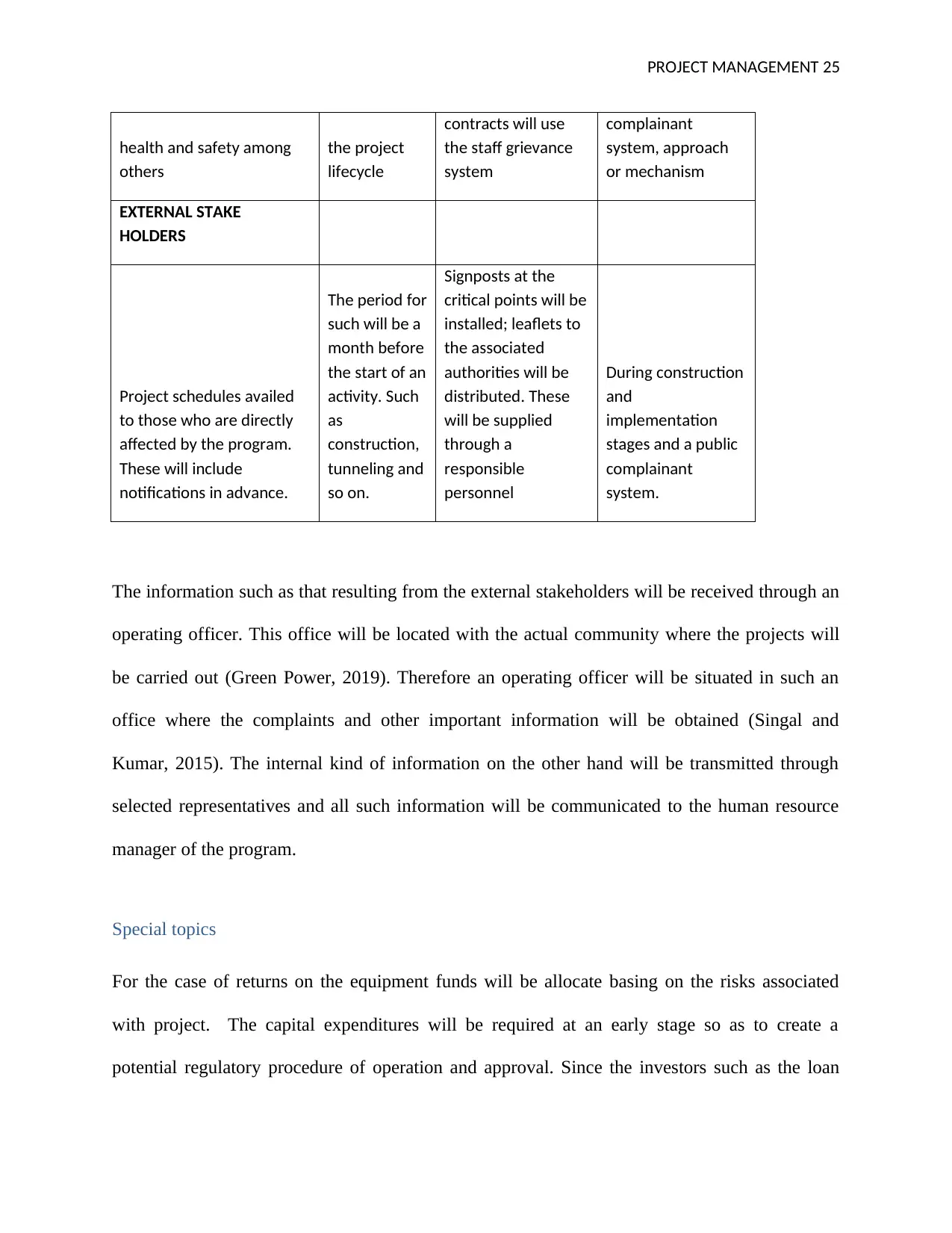
PROJECT MANAGEMENT 25
health and safety among
others
the project
lifecycle
contracts will use
the staff grievance
system
complainant
system, approach
or mechanism
EXTERNAL STAKE
HOLDERS
Project schedules availed
to those who are directly
affected by the program.
These will include
notifications in advance.
The period for
such will be a
month before
the start of an
activity. Such
as
construction,
tunneling and
so on.
Signposts at the
critical points will be
installed; leaflets to
the associated
authorities will be
distributed. These
will be supplied
through a
responsible
personnel
During construction
and
implementation
stages and a public
complainant
system.
The information such as that resulting from the external stakeholders will be received through an
operating officer. This office will be located with the actual community where the projects will
be carried out (Green Power, 2019). Therefore an operating officer will be situated in such an
office where the complaints and other important information will be obtained (Singal and
Kumar, 2015). The internal kind of information on the other hand will be transmitted through
selected representatives and all such information will be communicated to the human resource
manager of the program.
Special topics
For the case of returns on the equipment funds will be allocate basing on the risks associated
with project. The capital expenditures will be required at an early stage so as to create a
potential regulatory procedure of operation and approval. Since the investors such as the loan
health and safety among
others
the project
lifecycle
contracts will use
the staff grievance
system
complainant
system, approach
or mechanism
EXTERNAL STAKE
HOLDERS
Project schedules availed
to those who are directly
affected by the program.
These will include
notifications in advance.
The period for
such will be a
month before
the start of an
activity. Such
as
construction,
tunneling and
so on.
Signposts at the
critical points will be
installed; leaflets to
the associated
authorities will be
distributed. These
will be supplied
through a
responsible
personnel
During construction
and
implementation
stages and a public
complainant
system.
The information such as that resulting from the external stakeholders will be received through an
operating officer. This office will be located with the actual community where the projects will
be carried out (Green Power, 2019). Therefore an operating officer will be situated in such an
office where the complaints and other important information will be obtained (Singal and
Kumar, 2015). The internal kind of information on the other hand will be transmitted through
selected representatives and all such information will be communicated to the human resource
manager of the program.
Special topics
For the case of returns on the equipment funds will be allocate basing on the risks associated
with project. The capital expenditures will be required at an early stage so as to create a
potential regulatory procedure of operation and approval. Since the investors such as the loan
Paraphrase This Document
Need a fresh take? Get an instant paraphrase of this document with our AI Paraphraser
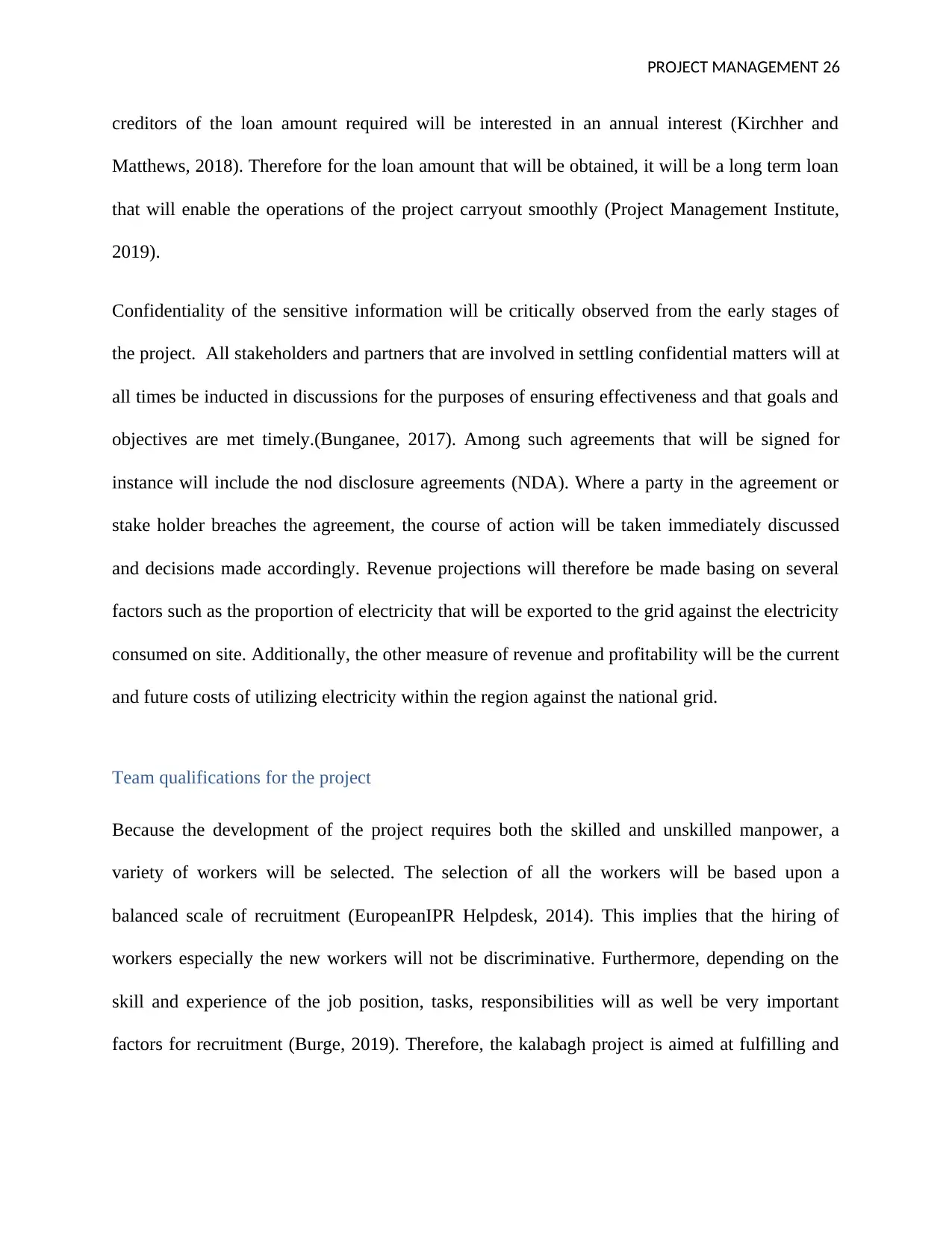
PROJECT MANAGEMENT 26
creditors of the loan amount required will be interested in an annual interest (Kirchher and
Matthews, 2018). Therefore for the loan amount that will be obtained, it will be a long term loan
that will enable the operations of the project carryout smoothly (Project Management Institute,
2019).
Confidentiality of the sensitive information will be critically observed from the early stages of
the project. All stakeholders and partners that are involved in settling confidential matters will at
all times be inducted in discussions for the purposes of ensuring effectiveness and that goals and
objectives are met timely.(Bunganee, 2017). Among such agreements that will be signed for
instance will include the nod disclosure agreements (NDA). Where a party in the agreement or
stake holder breaches the agreement, the course of action will be taken immediately discussed
and decisions made accordingly. Revenue projections will therefore be made basing on several
factors such as the proportion of electricity that will be exported to the grid against the electricity
consumed on site. Additionally, the other measure of revenue and profitability will be the current
and future costs of utilizing electricity within the region against the national grid.
Team qualifications for the project
Because the development of the project requires both the skilled and unskilled manpower, a
variety of workers will be selected. The selection of all the workers will be based upon a
balanced scale of recruitment (EuropeanIPR Helpdesk, 2014). This implies that the hiring of
workers especially the new workers will not be discriminative. Furthermore, depending on the
skill and experience of the job position, tasks, responsibilities will as well be very important
factors for recruitment (Burge, 2019). Therefore, the kalabagh project is aimed at fulfilling and
creditors of the loan amount required will be interested in an annual interest (Kirchher and
Matthews, 2018). Therefore for the loan amount that will be obtained, it will be a long term loan
that will enable the operations of the project carryout smoothly (Project Management Institute,
2019).
Confidentiality of the sensitive information will be critically observed from the early stages of
the project. All stakeholders and partners that are involved in settling confidential matters will at
all times be inducted in discussions for the purposes of ensuring effectiveness and that goals and
objectives are met timely.(Bunganee, 2017). Among such agreements that will be signed for
instance will include the nod disclosure agreements (NDA). Where a party in the agreement or
stake holder breaches the agreement, the course of action will be taken immediately discussed
and decisions made accordingly. Revenue projections will therefore be made basing on several
factors such as the proportion of electricity that will be exported to the grid against the electricity
consumed on site. Additionally, the other measure of revenue and profitability will be the current
and future costs of utilizing electricity within the region against the national grid.
Team qualifications for the project
Because the development of the project requires both the skilled and unskilled manpower, a
variety of workers will be selected. The selection of all the workers will be based upon a
balanced scale of recruitment (EuropeanIPR Helpdesk, 2014). This implies that the hiring of
workers especially the new workers will not be discriminative. Furthermore, depending on the
skill and experience of the job position, tasks, responsibilities will as well be very important
factors for recruitment (Burge, 2019). Therefore, the kalabagh project is aimed at fulfilling and
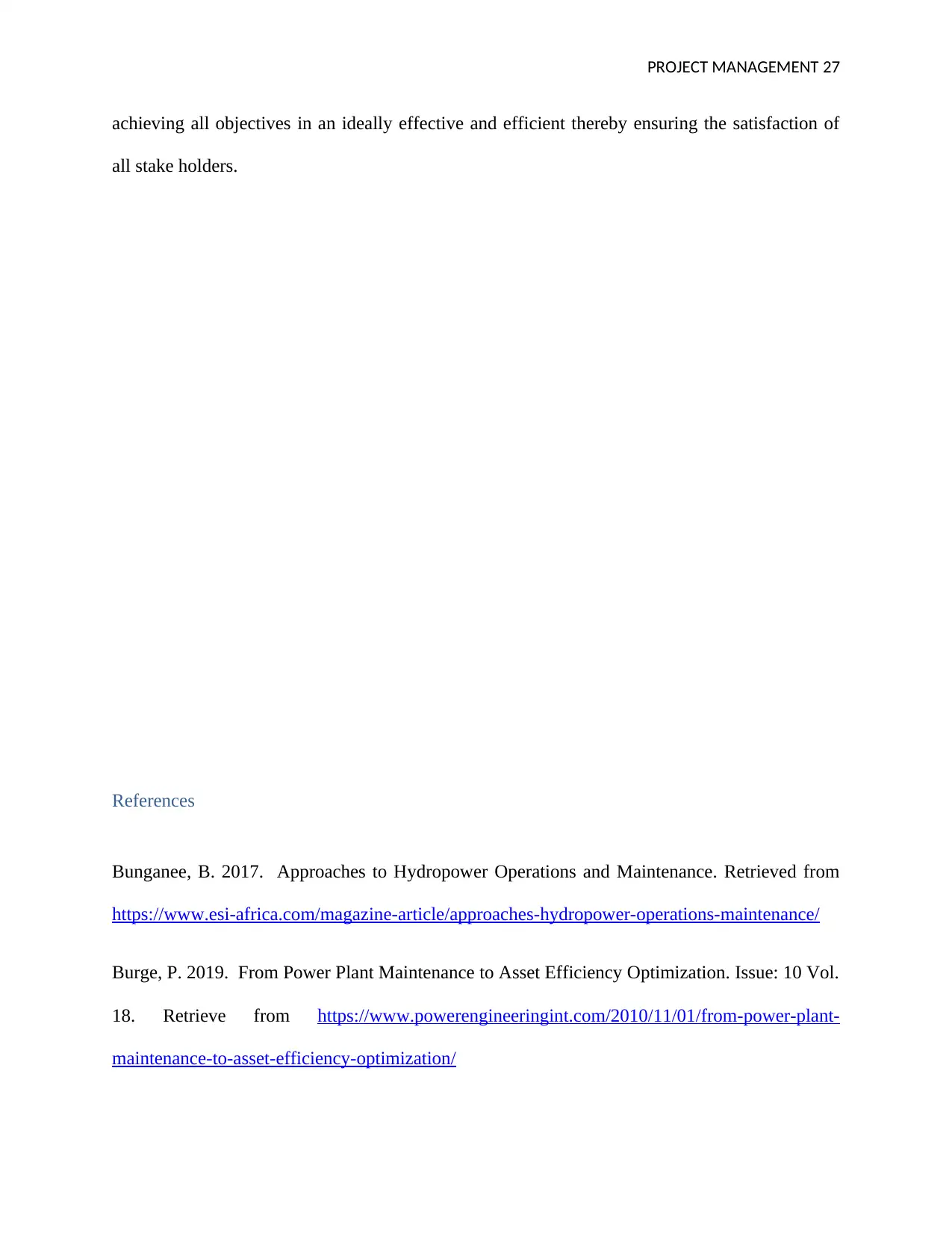
PROJECT MANAGEMENT 27
achieving all objectives in an ideally effective and efficient thereby ensuring the satisfaction of
all stake holders.
References
Bunganee, B. 2017. Approaches to Hydropower Operations and Maintenance. Retrieved from
https://www.esi-africa.com/magazine-article/approaches-hydropower-operations-maintenance/
Burge, P. 2019. From Power Plant Maintenance to Asset Efficiency Optimization. Issue: 10 Vol.
18. Retrieve from https://www.powerengineeringint.com/2010/11/01/from-power-plant-
maintenance-to-asset-efficiency-optimization/
achieving all objectives in an ideally effective and efficient thereby ensuring the satisfaction of
all stake holders.
References
Bunganee, B. 2017. Approaches to Hydropower Operations and Maintenance. Retrieved from
https://www.esi-africa.com/magazine-article/approaches-hydropower-operations-maintenance/
Burge, P. 2019. From Power Plant Maintenance to Asset Efficiency Optimization. Issue: 10 Vol.
18. Retrieve from https://www.powerengineeringint.com/2010/11/01/from-power-plant-
maintenance-to-asset-efficiency-optimization/
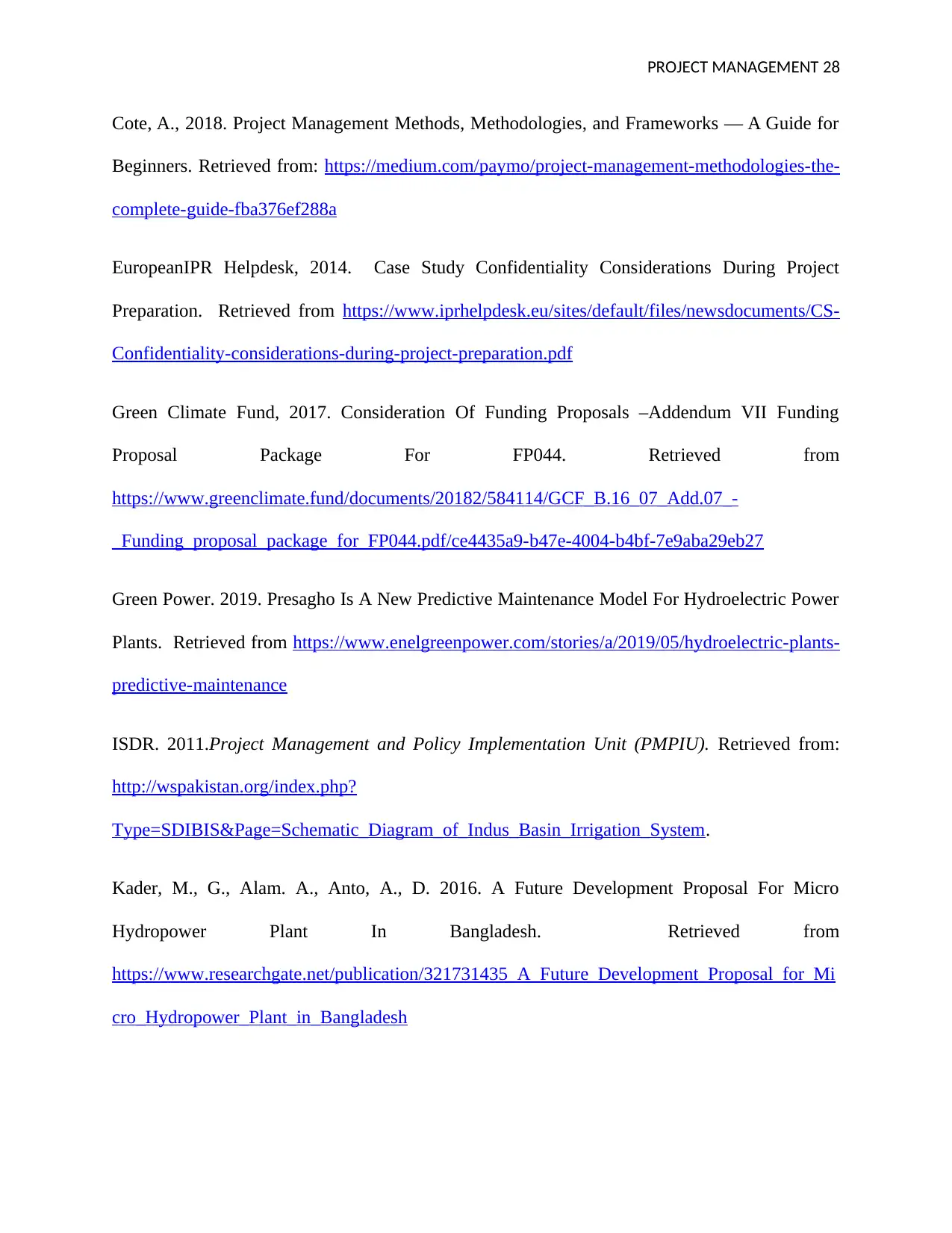
PROJECT MANAGEMENT 28
Cote, A., 2018. Project Management Methods, Methodologies, and Frameworks — A Guide for
Beginners. Retrieved from: https://medium.com/paymo/project-management-methodologies-the-
complete-guide-fba376ef288a
EuropeanIPR Helpdesk, 2014. Case Study Confidentiality Considerations During Project
Preparation. Retrieved from https://www.iprhelpdesk.eu/sites/default/files/newsdocuments/CS-
Confidentiality-considerations-during-project-preparation.pdf
Green Climate Fund, 2017. Consideration Of Funding Proposals –Addendum VII Funding
Proposal Package For FP044. Retrieved from
https://www.greenclimate.fund/documents/20182/584114/GCF_B.16_07_Add.07_-
_Funding_proposal_package_for_FP044.pdf/ce4435a9-b47e-4004-b4bf-7e9aba29eb27
Green Power. 2019. Presagho Is A New Predictive Maintenance Model For Hydroelectric Power
Plants. Retrieved from https://www.enelgreenpower.com/stories/a/2019/05/hydroelectric-plants-
predictive-maintenance
ISDR. 2011.Project Management and Policy Implementation Unit (PMPIU). Retrieved from:
http://wspakistan.org/index.php?
Type=SDIBIS&Page=Schematic_Diagram_of_Indus_Basin_Irrigation_System.
Kader, M., G., Alam. A., Anto, A., D. 2016. A Future Development Proposal For Micro
Hydropower Plant In Bangladesh. Retrieved from
https://www.researchgate.net/publication/321731435_A_Future_Development_Proposal_for_Mi
cro_Hydropower_Plant_in_Bangladesh
Cote, A., 2018. Project Management Methods, Methodologies, and Frameworks — A Guide for
Beginners. Retrieved from: https://medium.com/paymo/project-management-methodologies-the-
complete-guide-fba376ef288a
EuropeanIPR Helpdesk, 2014. Case Study Confidentiality Considerations During Project
Preparation. Retrieved from https://www.iprhelpdesk.eu/sites/default/files/newsdocuments/CS-
Confidentiality-considerations-during-project-preparation.pdf
Green Climate Fund, 2017. Consideration Of Funding Proposals –Addendum VII Funding
Proposal Package For FP044. Retrieved from
https://www.greenclimate.fund/documents/20182/584114/GCF_B.16_07_Add.07_-
_Funding_proposal_package_for_FP044.pdf/ce4435a9-b47e-4004-b4bf-7e9aba29eb27
Green Power. 2019. Presagho Is A New Predictive Maintenance Model For Hydroelectric Power
Plants. Retrieved from https://www.enelgreenpower.com/stories/a/2019/05/hydroelectric-plants-
predictive-maintenance
ISDR. 2011.Project Management and Policy Implementation Unit (PMPIU). Retrieved from:
http://wspakistan.org/index.php?
Type=SDIBIS&Page=Schematic_Diagram_of_Indus_Basin_Irrigation_System.
Kader, M., G., Alam. A., Anto, A., D. 2016. A Future Development Proposal For Micro
Hydropower Plant In Bangladesh. Retrieved from
https://www.researchgate.net/publication/321731435_A_Future_Development_Proposal_for_Mi
cro_Hydropower_Plant_in_Bangladesh
Secure Best Marks with AI Grader
Need help grading? Try our AI Grader for instant feedback on your assignments.
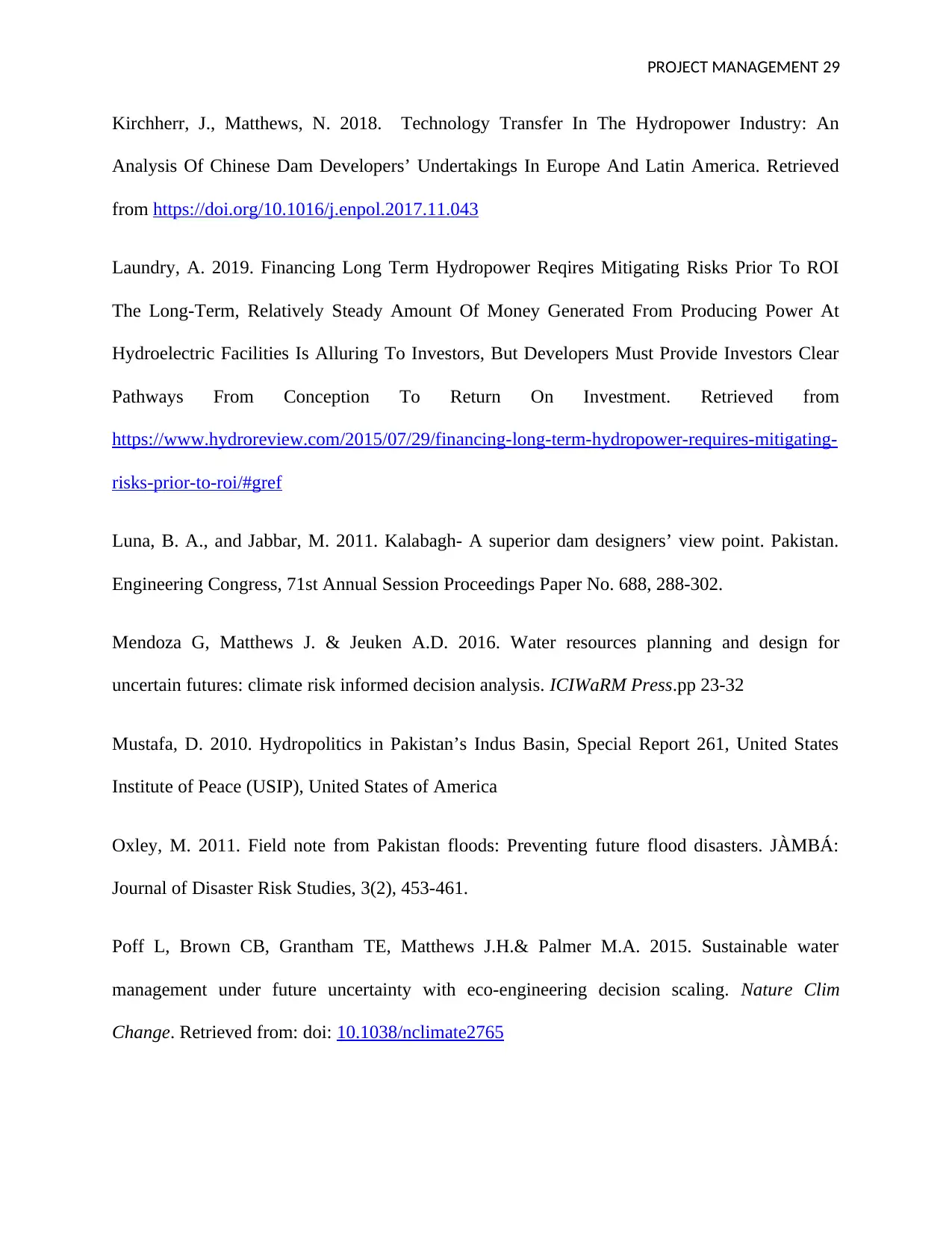
PROJECT MANAGEMENT 29
Kirchherr, J., Matthews, N. 2018. Technology Transfer In The Hydropower Industry: An
Analysis Of Chinese Dam Developers’ Undertakings In Europe And Latin America. Retrieved
from https://doi.org/10.1016/j.enpol.2017.11.043
Laundry, A. 2019. Financing Long Term Hydropower Reqires Mitigating Risks Prior To ROI
The Long-Term, Relatively Steady Amount Of Money Generated From Producing Power At
Hydroelectric Facilities Is Alluring To Investors, But Developers Must Provide Investors Clear
Pathways From Conception To Return On Investment. Retrieved from
https://www.hydroreview.com/2015/07/29/financing-long-term-hydropower-requires-mitigating-
risks-prior-to-roi/#gref
Luna, B. A., and Jabbar, M. 2011. Kalabagh- A superior dam designers’ view point. Pakistan.
Engineering Congress, 71st Annual Session Proceedings Paper No. 688, 288-302.
Mendoza G, Matthews J. & Jeuken A.D. 2016. Water resources planning and design for
uncertain futures: climate risk informed decision analysis. ICIWaRM Press.pp 23-32
Mustafa, D. 2010. Hydropolitics in Pakistan’s Indus Basin, Special Report 261, United States
Institute of Peace (USIP), United States of America
Oxley, M. 2011. Field note from Pakistan floods: Preventing future flood disasters. JÀMBÁ:
Journal of Disaster Risk Studies, 3(2), 453-461.
Poff L, Brown CB, Grantham TE, Matthews J.H.& Palmer M.A. 2015. Sustainable water
management under future uncertainty with eco-engineering decision scaling. Nature Clim
Change. Retrieved from: doi: 10.1038/nclimate2765
Kirchherr, J., Matthews, N. 2018. Technology Transfer In The Hydropower Industry: An
Analysis Of Chinese Dam Developers’ Undertakings In Europe And Latin America. Retrieved
from https://doi.org/10.1016/j.enpol.2017.11.043
Laundry, A. 2019. Financing Long Term Hydropower Reqires Mitigating Risks Prior To ROI
The Long-Term, Relatively Steady Amount Of Money Generated From Producing Power At
Hydroelectric Facilities Is Alluring To Investors, But Developers Must Provide Investors Clear
Pathways From Conception To Return On Investment. Retrieved from
https://www.hydroreview.com/2015/07/29/financing-long-term-hydropower-requires-mitigating-
risks-prior-to-roi/#gref
Luna, B. A., and Jabbar, M. 2011. Kalabagh- A superior dam designers’ view point. Pakistan.
Engineering Congress, 71st Annual Session Proceedings Paper No. 688, 288-302.
Mendoza G, Matthews J. & Jeuken A.D. 2016. Water resources planning and design for
uncertain futures: climate risk informed decision analysis. ICIWaRM Press.pp 23-32
Mustafa, D. 2010. Hydropolitics in Pakistan’s Indus Basin, Special Report 261, United States
Institute of Peace (USIP), United States of America
Oxley, M. 2011. Field note from Pakistan floods: Preventing future flood disasters. JÀMBÁ:
Journal of Disaster Risk Studies, 3(2), 453-461.
Poff L, Brown CB, Grantham TE, Matthews J.H.& Palmer M.A. 2015. Sustainable water
management under future uncertainty with eco-engineering decision scaling. Nature Clim
Change. Retrieved from: doi: 10.1038/nclimate2765
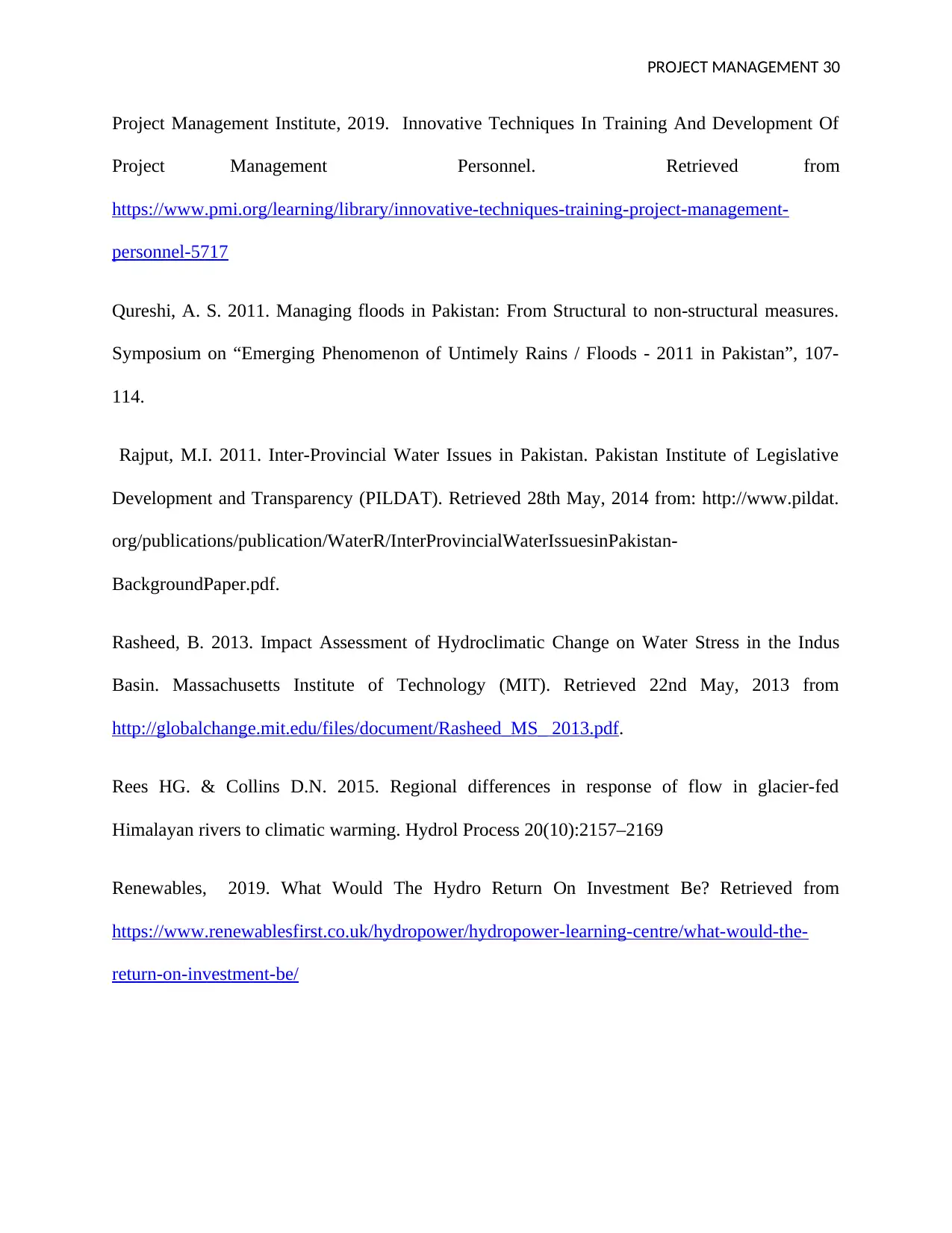
PROJECT MANAGEMENT 30
Project Management Institute, 2019. Innovative Techniques In Training And Development Of
Project Management Personnel. Retrieved from
https://www.pmi.org/learning/library/innovative-techniques-training-project-management-
personnel-5717
Qureshi, A. S. 2011. Managing floods in Pakistan: From Structural to non-structural measures.
Symposium on “Emerging Phenomenon of Untimely Rains / Floods - 2011 in Pakistan”, 107-
114.
Rajput, M.I. 2011. Inter-Provincial Water Issues in Pakistan. Pakistan Institute of Legislative
Development and Transparency (PILDAT). Retrieved 28th May, 2014 from: http://www.pildat.
org/publications/publication/WaterR/InterProvincialWaterIssuesinPakistan-
BackgroundPaper.pdf.
Rasheed, B. 2013. Impact Assessment of Hydroclimatic Change on Water Stress in the Indus
Basin. Massachusetts Institute of Technology (MIT). Retrieved 22nd May, 2013 from
http://globalchange.mit.edu/files/document/Rasheed_MS_ 2013.pdf.
Rees HG. & Collins D.N. 2015. Regional differences in response of flow in glacier-fed
Himalayan rivers to climatic warming. Hydrol Process 20(10):2157–2169
Renewables, 2019. What Would The Hydro Return On Investment Be? Retrieved from
https://www.renewablesfirst.co.uk/hydropower/hydropower-learning-centre/what-would-the-
return-on-investment-be/
Project Management Institute, 2019. Innovative Techniques In Training And Development Of
Project Management Personnel. Retrieved from
https://www.pmi.org/learning/library/innovative-techniques-training-project-management-
personnel-5717
Qureshi, A. S. 2011. Managing floods in Pakistan: From Structural to non-structural measures.
Symposium on “Emerging Phenomenon of Untimely Rains / Floods - 2011 in Pakistan”, 107-
114.
Rajput, M.I. 2011. Inter-Provincial Water Issues in Pakistan. Pakistan Institute of Legislative
Development and Transparency (PILDAT). Retrieved 28th May, 2014 from: http://www.pildat.
org/publications/publication/WaterR/InterProvincialWaterIssuesinPakistan-
BackgroundPaper.pdf.
Rasheed, B. 2013. Impact Assessment of Hydroclimatic Change on Water Stress in the Indus
Basin. Massachusetts Institute of Technology (MIT). Retrieved 22nd May, 2013 from
http://globalchange.mit.edu/files/document/Rasheed_MS_ 2013.pdf.
Rees HG. & Collins D.N. 2015. Regional differences in response of flow in glacier-fed
Himalayan rivers to climatic warming. Hydrol Process 20(10):2157–2169
Renewables, 2019. What Would The Hydro Return On Investment Be? Retrieved from
https://www.renewablesfirst.co.uk/hydropower/hydropower-learning-centre/what-would-the-
return-on-investment-be/
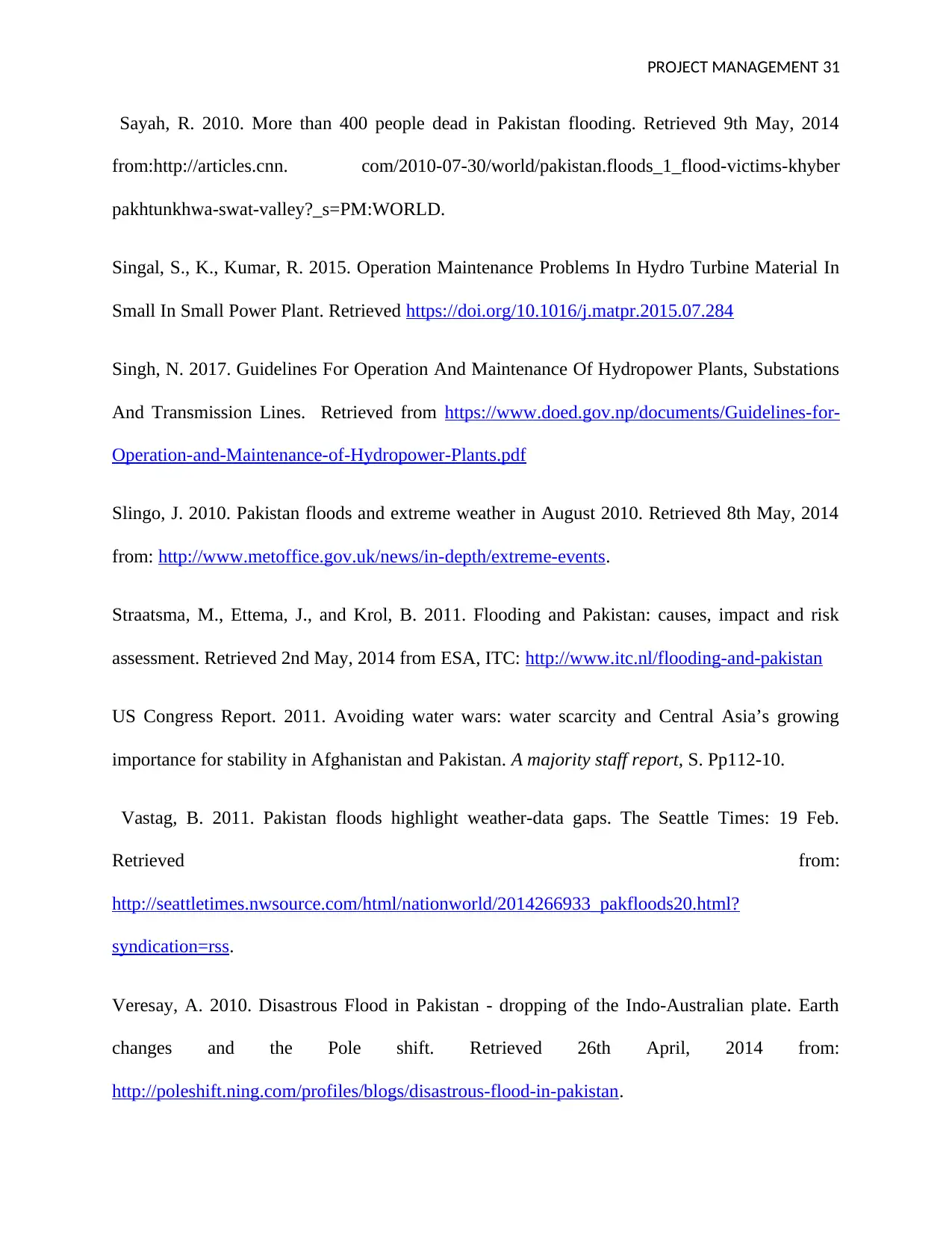
PROJECT MANAGEMENT 31
Sayah, R. 2010. More than 400 people dead in Pakistan flooding. Retrieved 9th May, 2014
from:http://articles.cnn. com/2010-07-30/world/pakistan.floods_1_flood-victims-khyber
pakhtunkhwa-swat-valley?_s=PM:WORLD.
Singal, S., K., Kumar, R. 2015. Operation Maintenance Problems In Hydro Turbine Material In
Small In Small Power Plant. Retrieved https://doi.org/10.1016/j.matpr.2015.07.284
Singh, N. 2017. Guidelines For Operation And Maintenance Of Hydropower Plants, Substations
And Transmission Lines. Retrieved from https://www.doed.gov.np/documents/Guidelines-for-
Operation-and-Maintenance-of-Hydropower-Plants.pdf
Slingo, J. 2010. Pakistan floods and extreme weather in August 2010. Retrieved 8th May, 2014
from: http://www.metoffice.gov.uk/news/in-depth/extreme-events.
Straatsma, M., Ettema, J., and Krol, B. 2011. Flooding and Pakistan: causes, impact and risk
assessment. Retrieved 2nd May, 2014 from ESA, ITC: http://www.itc.nl/flooding-and-pakistan
US Congress Report. 2011. Avoiding water wars: water scarcity and Central Asia’s growing
importance for stability in Afghanistan and Pakistan. A majority staff report, S. Pp112-10.
Vastag, B. 2011. Pakistan floods highlight weather-data gaps. The Seattle Times: 19 Feb.
Retrieved from:
http://seattletimes.nwsource.com/html/nationworld/2014266933_pakfloods20.html?
syndication=rss.
Veresay, A. 2010. Disastrous Flood in Pakistan - dropping of the Indo-Australian plate. Earth
changes and the Pole shift. Retrieved 26th April, 2014 from:
http://poleshift.ning.com/profiles/blogs/disastrous-flood-in-pakistan.
Sayah, R. 2010. More than 400 people dead in Pakistan flooding. Retrieved 9th May, 2014
from:http://articles.cnn. com/2010-07-30/world/pakistan.floods_1_flood-victims-khyber
pakhtunkhwa-swat-valley?_s=PM:WORLD.
Singal, S., K., Kumar, R. 2015. Operation Maintenance Problems In Hydro Turbine Material In
Small In Small Power Plant. Retrieved https://doi.org/10.1016/j.matpr.2015.07.284
Singh, N. 2017. Guidelines For Operation And Maintenance Of Hydropower Plants, Substations
And Transmission Lines. Retrieved from https://www.doed.gov.np/documents/Guidelines-for-
Operation-and-Maintenance-of-Hydropower-Plants.pdf
Slingo, J. 2010. Pakistan floods and extreme weather in August 2010. Retrieved 8th May, 2014
from: http://www.metoffice.gov.uk/news/in-depth/extreme-events.
Straatsma, M., Ettema, J., and Krol, B. 2011. Flooding and Pakistan: causes, impact and risk
assessment. Retrieved 2nd May, 2014 from ESA, ITC: http://www.itc.nl/flooding-and-pakistan
US Congress Report. 2011. Avoiding water wars: water scarcity and Central Asia’s growing
importance for stability in Afghanistan and Pakistan. A majority staff report, S. Pp112-10.
Vastag, B. 2011. Pakistan floods highlight weather-data gaps. The Seattle Times: 19 Feb.
Retrieved from:
http://seattletimes.nwsource.com/html/nationworld/2014266933_pakfloods20.html?
syndication=rss.
Veresay, A. 2010. Disastrous Flood in Pakistan - dropping of the Indo-Australian plate. Earth
changes and the Pole shift. Retrieved 26th April, 2014 from:
http://poleshift.ning.com/profiles/blogs/disastrous-flood-in-pakistan.
Paraphrase This Document
Need a fresh take? Get an instant paraphrase of this document with our AI Paraphraser
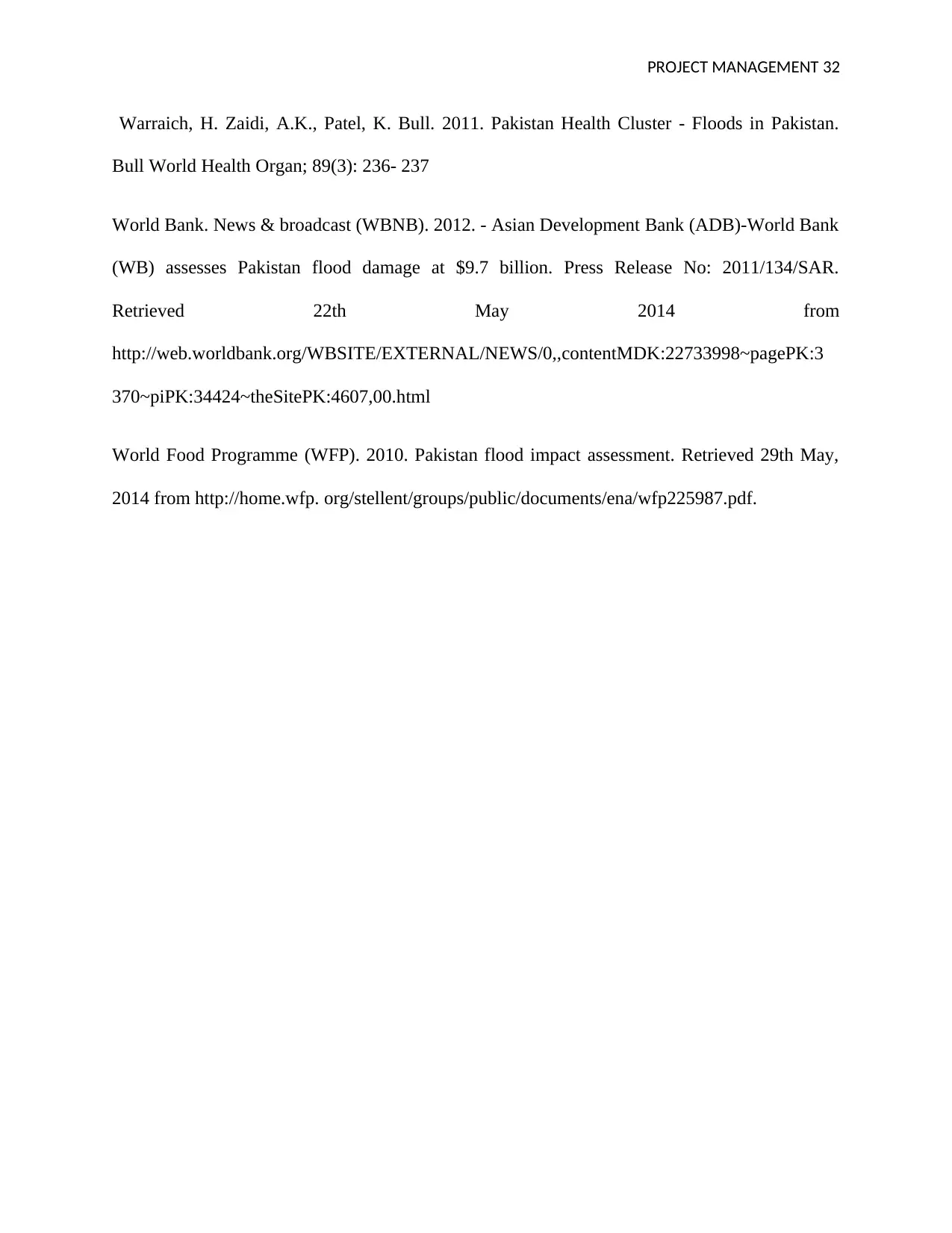
PROJECT MANAGEMENT 32
Warraich, H. Zaidi, A.K., Patel, K. Bull. 2011. Pakistan Health Cluster - Floods in Pakistan.
Bull World Health Organ; 89(3): 236- 237
World Bank. News & broadcast (WBNB). 2012. - Asian Development Bank (ADB)-World Bank
(WB) assesses Pakistan flood damage at $9.7 billion. Press Release No: 2011/134/SAR.
Retrieved 22th May 2014 from
http://web.worldbank.org/WBSITE/EXTERNAL/NEWS/0,,contentMDK:22733998~pagePK:3
370~piPK:34424~theSitePK:4607,00.html
World Food Programme (WFP). 2010. Pakistan flood impact assessment. Retrieved 29th May,
2014 from http://home.wfp. org/stellent/groups/public/documents/ena/wfp225987.pdf.
Warraich, H. Zaidi, A.K., Patel, K. Bull. 2011. Pakistan Health Cluster - Floods in Pakistan.
Bull World Health Organ; 89(3): 236- 237
World Bank. News & broadcast (WBNB). 2012. - Asian Development Bank (ADB)-World Bank
(WB) assesses Pakistan flood damage at $9.7 billion. Press Release No: 2011/134/SAR.
Retrieved 22th May 2014 from
http://web.worldbank.org/WBSITE/EXTERNAL/NEWS/0,,contentMDK:22733998~pagePK:3
370~piPK:34424~theSitePK:4607,00.html
World Food Programme (WFP). 2010. Pakistan flood impact assessment. Retrieved 29th May,
2014 from http://home.wfp. org/stellent/groups/public/documents/ena/wfp225987.pdf.
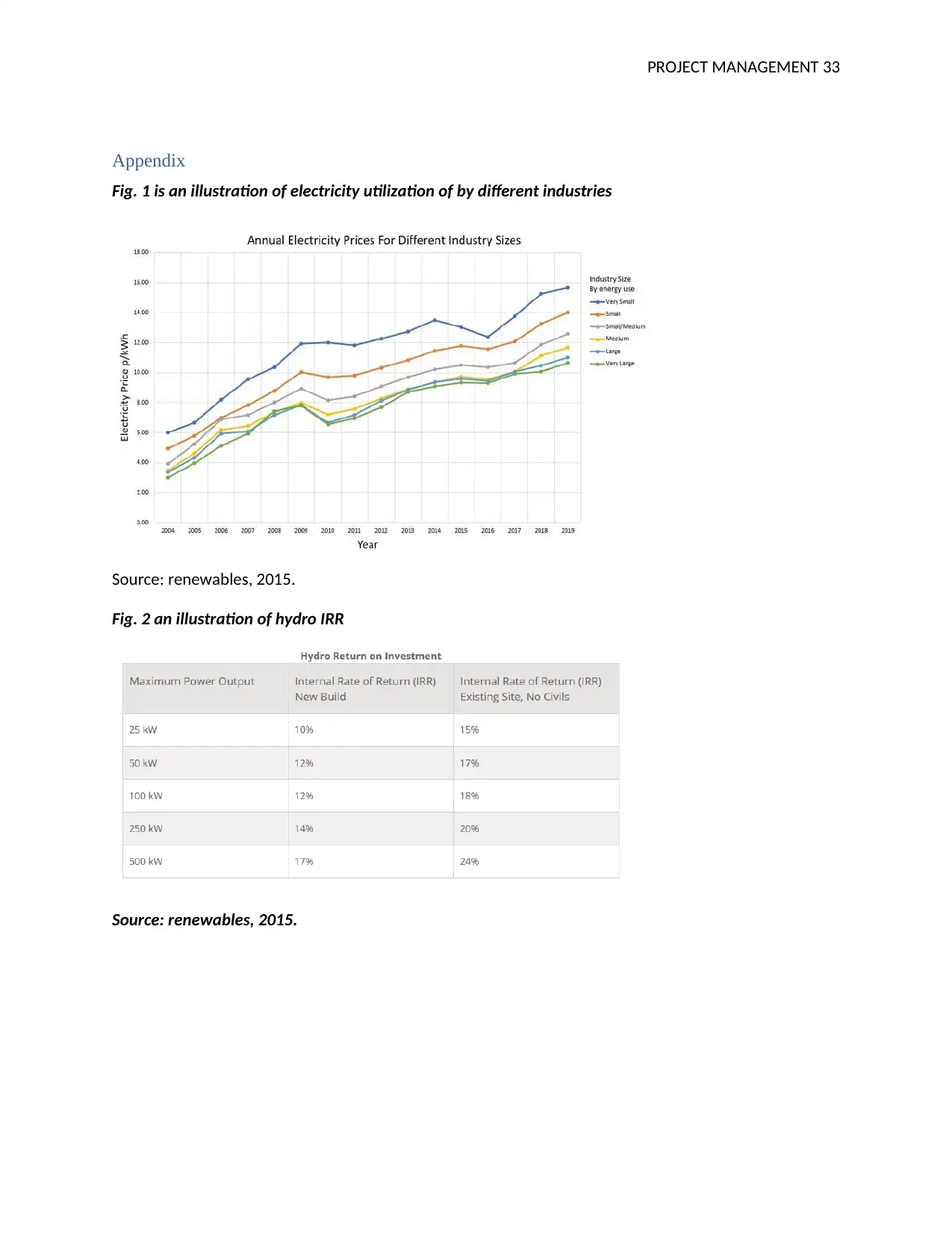
PROJECT MANAGEMENT 33
Appendix
Fig. 1 is an illustration of electricity utilization of by different industries
Source: renewables, 2015.
Fig. 2 an illustration of hydro IRR
Source: renewables, 2015.
Appendix
Fig. 1 is an illustration of electricity utilization of by different industries
Source: renewables, 2015.
Fig. 2 an illustration of hydro IRR
Source: renewables, 2015.
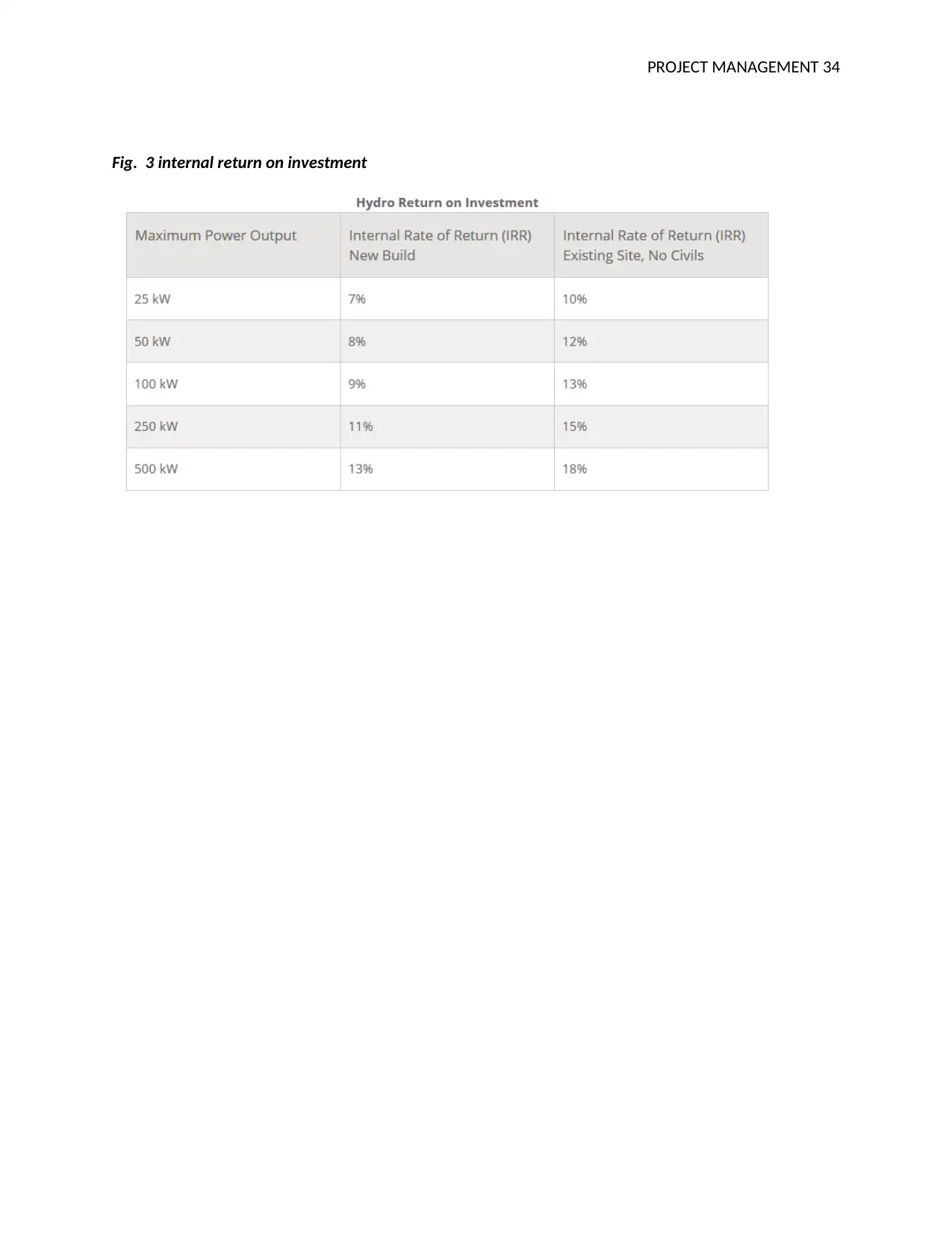
PROJECT MANAGEMENT 34
Fig. 3 internal return on investment
Fig. 3 internal return on investment
1 out of 34
Your All-in-One AI-Powered Toolkit for Academic Success.
+13062052269
info@desklib.com
Available 24*7 on WhatsApp / Email
![[object Object]](/_next/static/media/star-bottom.7253800d.svg)
Unlock your academic potential
© 2024 | Zucol Services PVT LTD | All rights reserved.